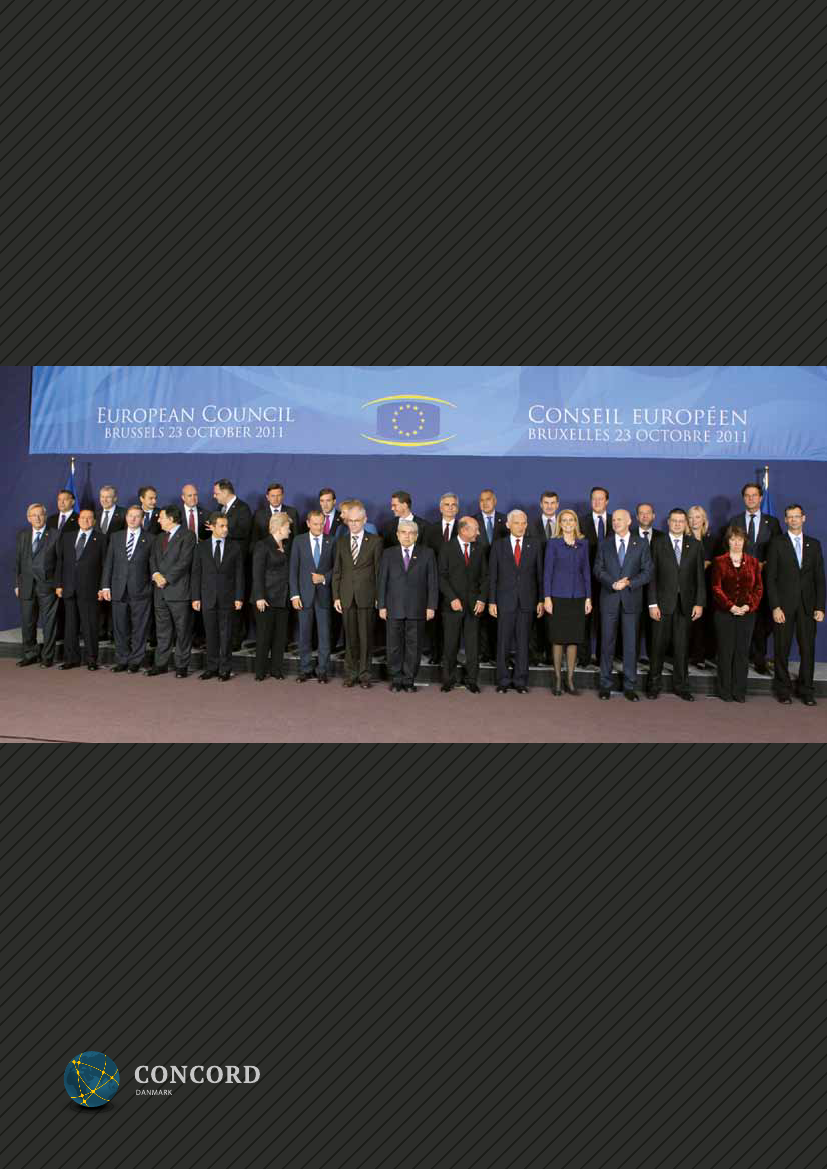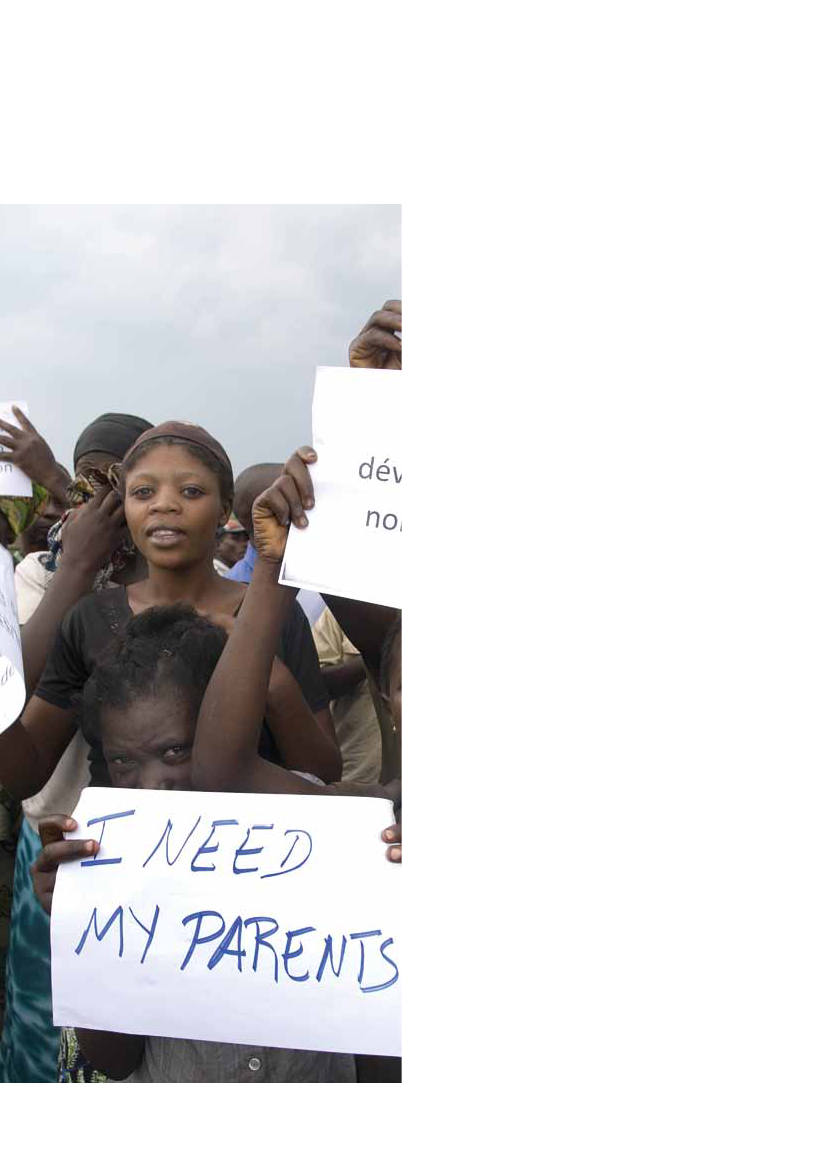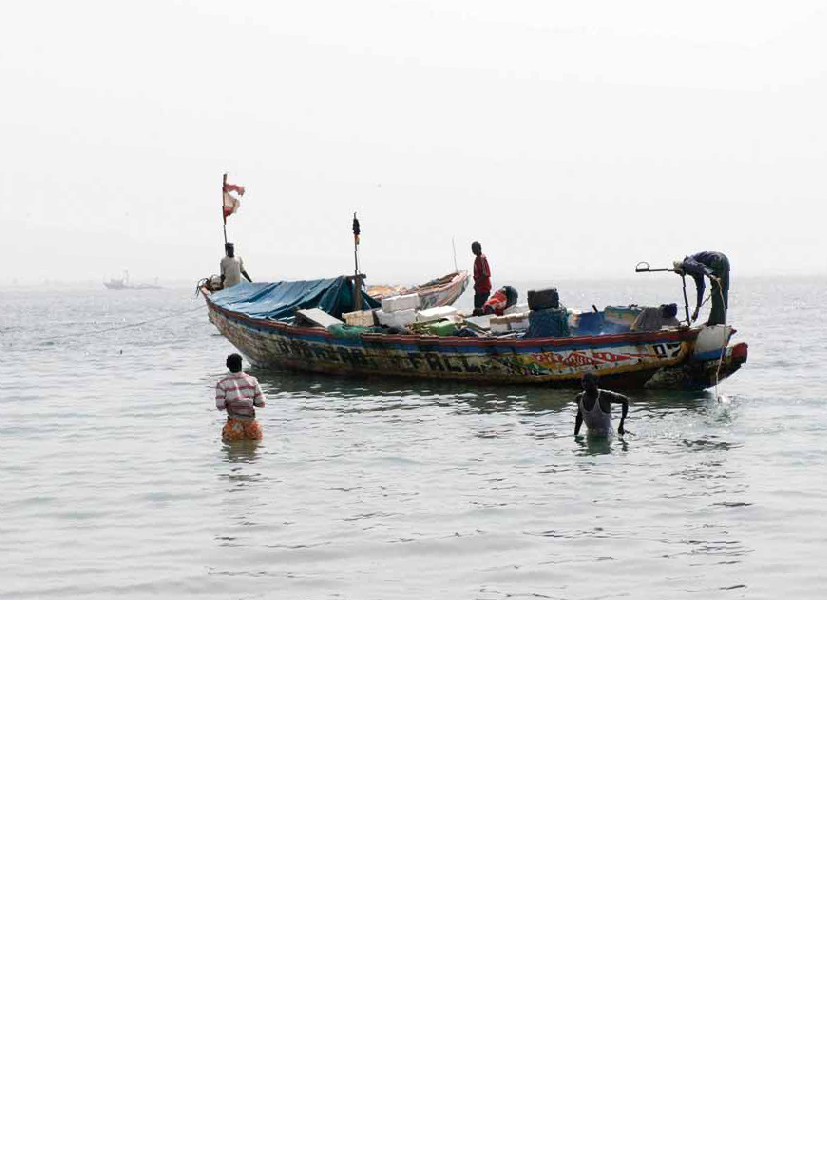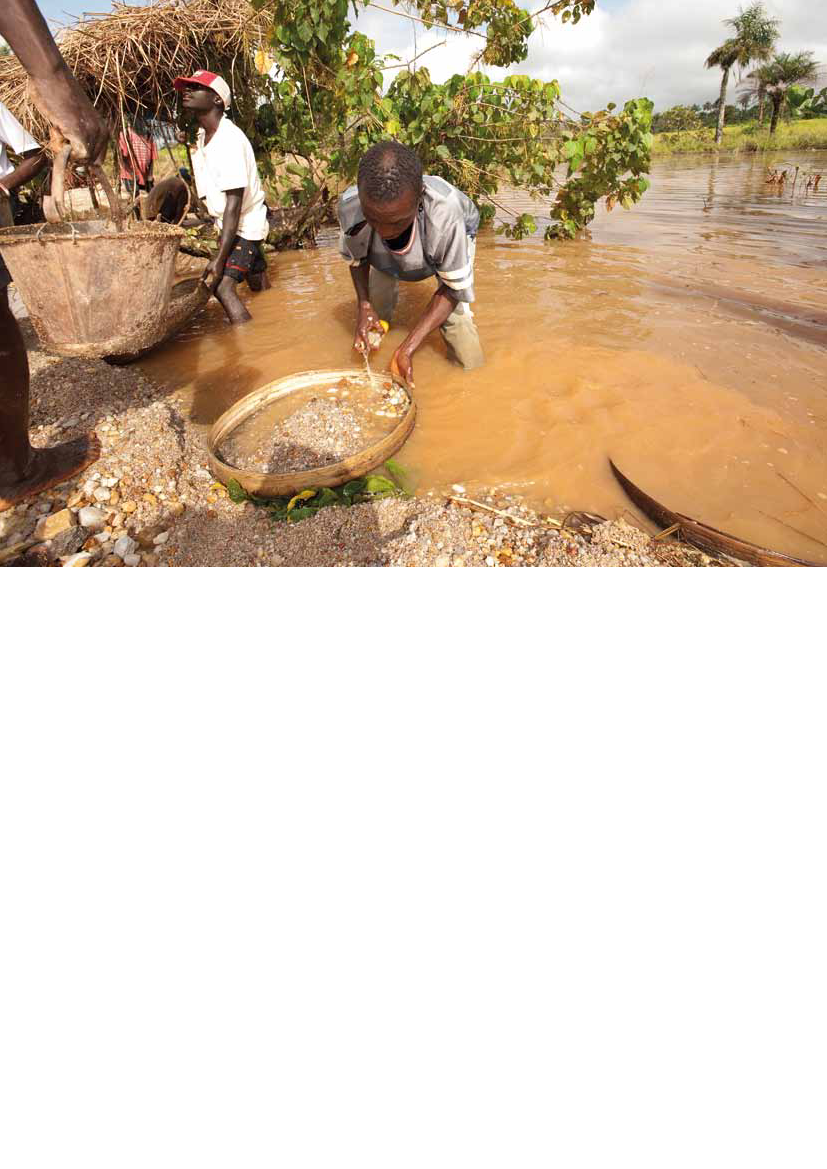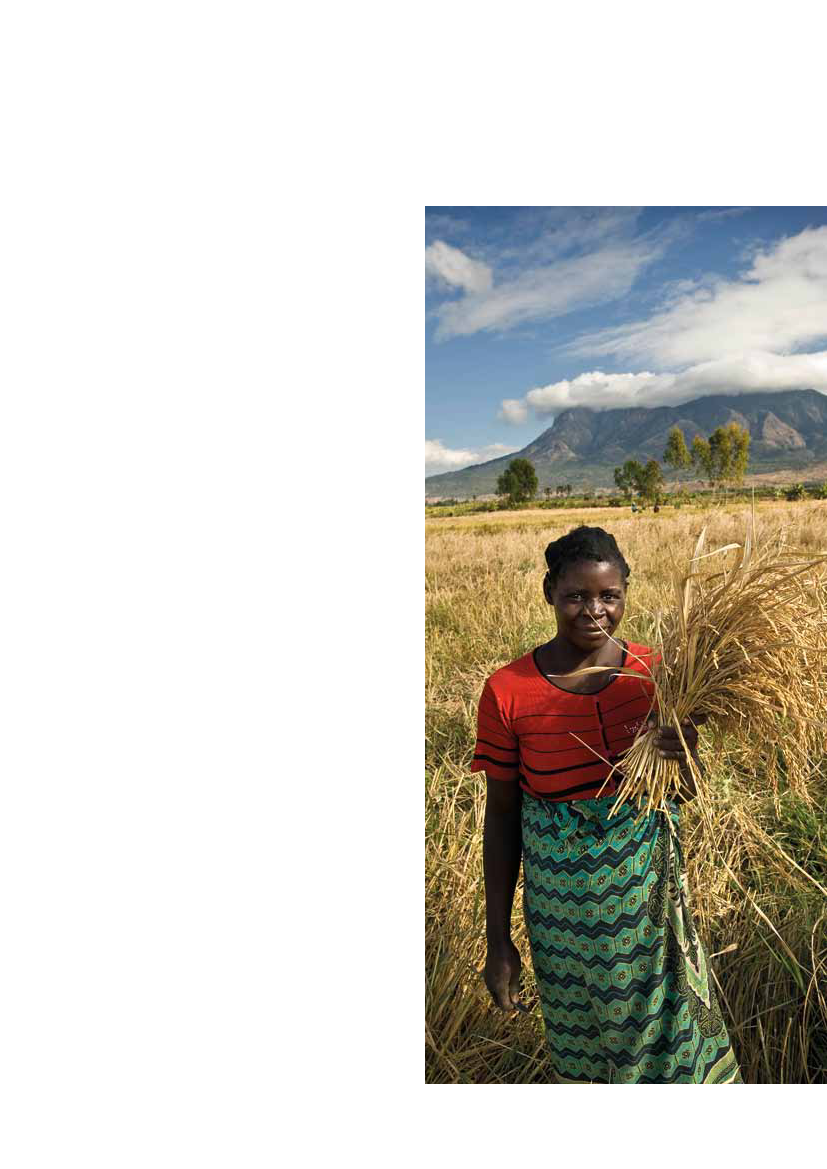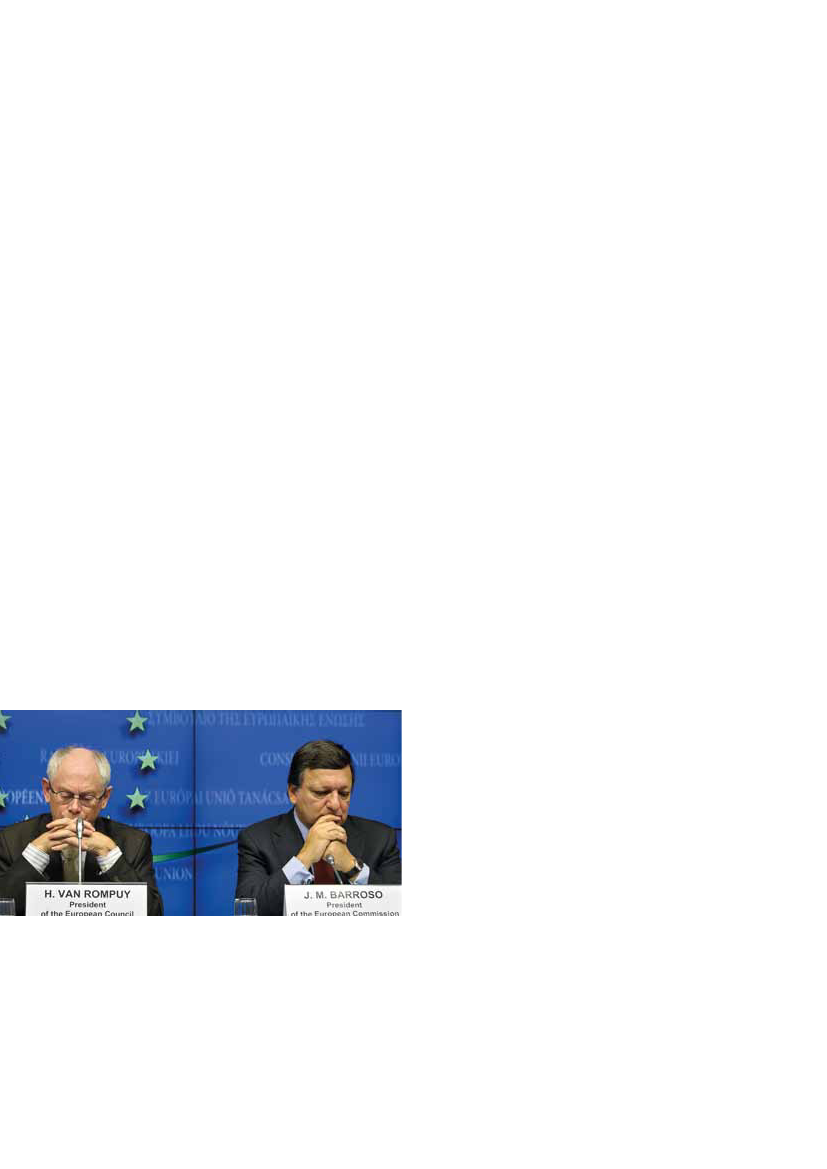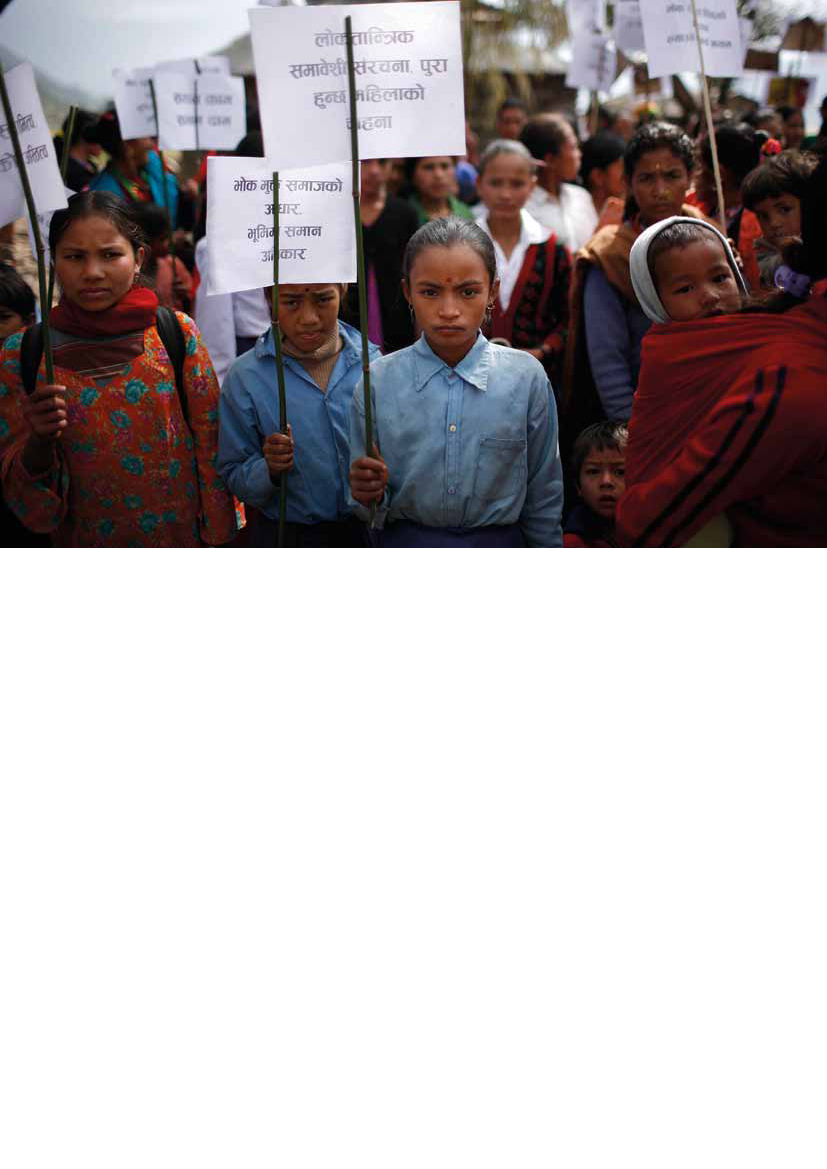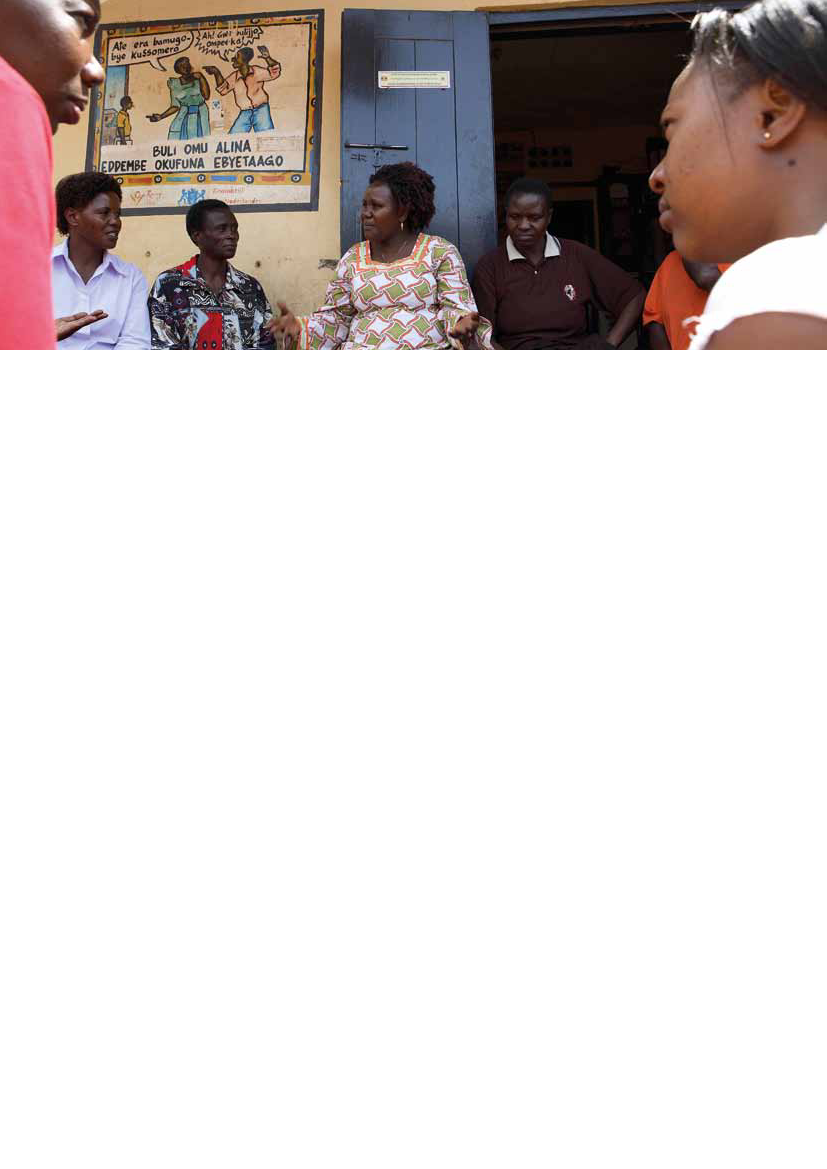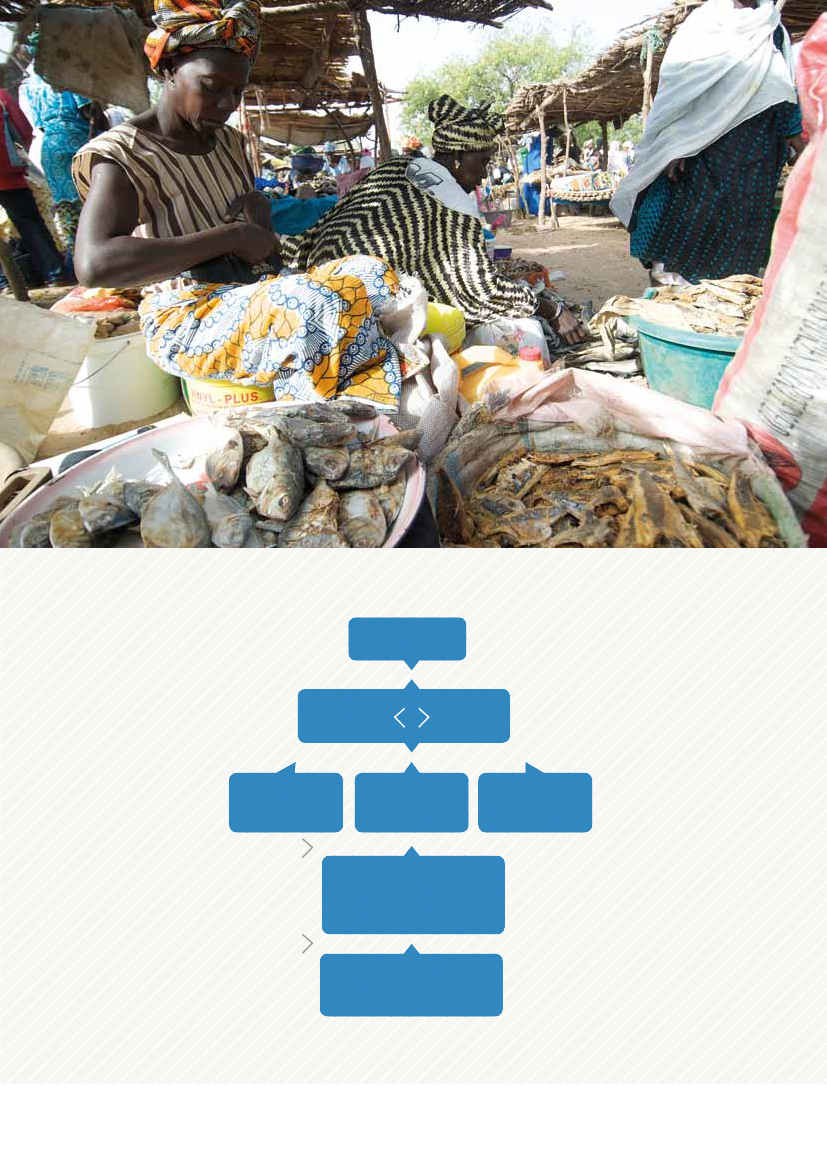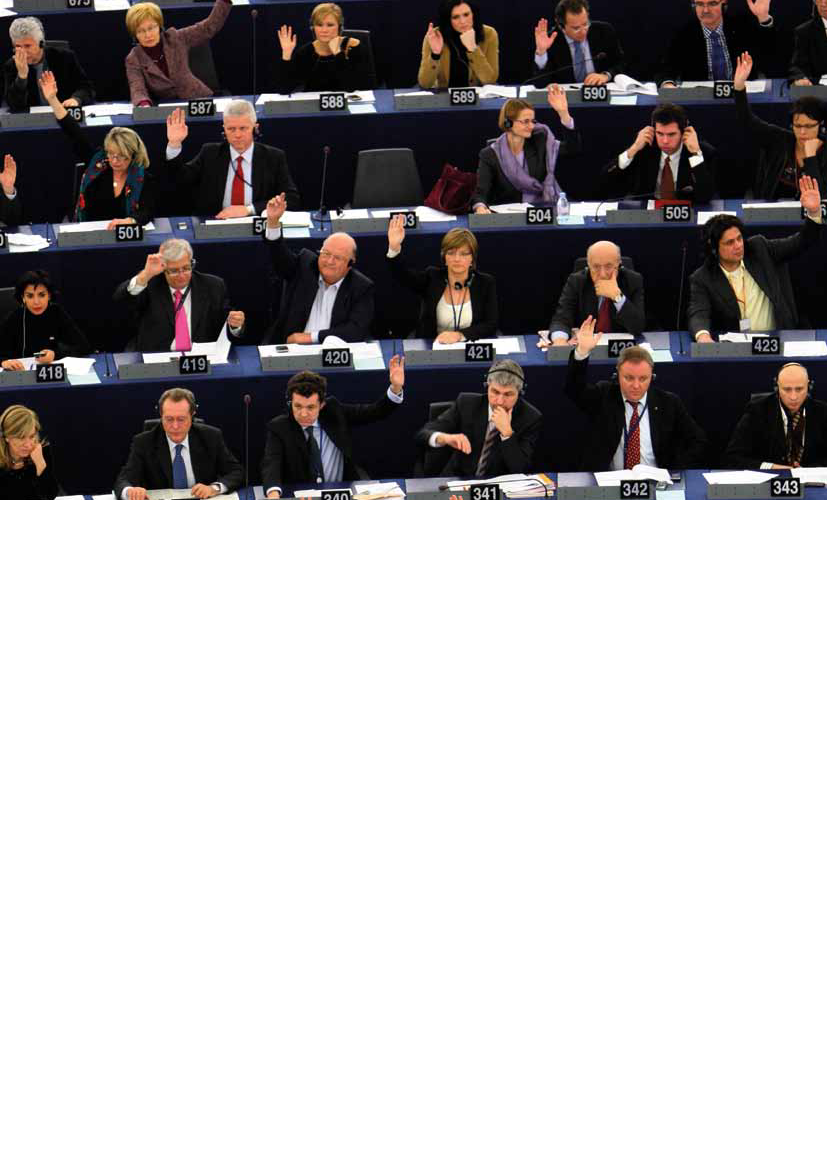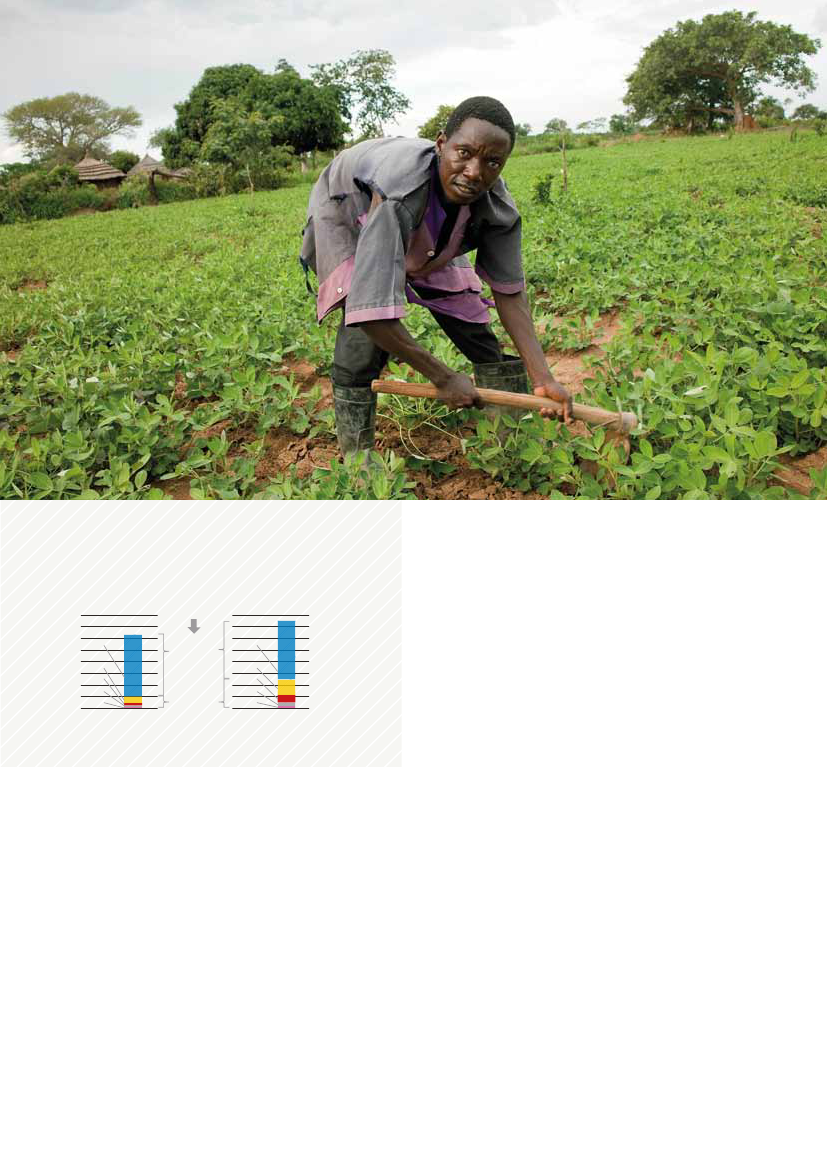Europaudvalget 2011-12
EUU Alm.del Bilag 496
Offentligt
Delivering results
– How Denmark can lead the way for Policy Coherence for Development
May 2012Concord Danmark ¶ Delivering results
1
AcknowledgementsThe report has benefited from the dedicated work of an internationalsteering group, which provided useful advice and comments. ConcordDenmark would like to thank the Steering Group for their time andcontributions. Please note that the conclusions and statements in thereport do not necessarily reflect the opinions of the international steeringgroup. Concord Denmark takes the full responsibility for the report.Report coordinator: Knud VilbyOverall responsibility: Laust Leth Gregersen, Adam Fejerskov and MortenEmil Hansen (Concord Denmark).Photo frontpage: POLFOTO/AP-Michel EulerGraphic Design: Ægir/KoefoedPrint: Jønsson Thomsen Elbo A/S
International steering groupEbba Dohlman:Head of the Policy Coherence forDevelopment Unit at the OECD and Senior Advisor to theSecretary-General.Each of the individual experts is responsible for their contributions to thethematic chapters:The introduction was contributed to by Knud Vilby, Laust Leth Gregersen(Concord Denmark), Adam Fejerskov (Concord Denmark) and MortenEmil Hansen (Concord Denmark).The EU Institutional Framework chapter was contributed by Niels Keijzer(ECDPM)The thematic chapter on Biofuels was contributed by Knud VilbyThe thematic chapter on Illicit Financial Flows was contributed byRaymond W. Baker (Global Financial Integrity). Sarah Johansen (ConcordDenmark) has contributed with vision and objectives.The thematic chapter on Agriculture and Food Security was contributedby Steve Wiggins (ODI)Morten Broberg:Professor, Faculty of Law, University ofCopenhagen. Morten Broberg has published extensively oninternational development and EU law including PolicyCoherence for Development and the regulation of EU tradewith developing countries.Rilli Lappalainen:Secretary General of Finnish NGDOplatform to the EU, member of CONCORD Europe boardwith PCD portfolio, former chair of PCD coordinationgroup.The chapter on the Danish operationalizing of PCD was contributed to byKnud Vilby, Laust Leth Gregersen (Concord Denmark), Adam Fejerskov(Concord Denmark) and Morten Emil Hansen (Concord Denmark).
Nanna Hvidt:Director of the Danish Institute forInternational Studies. Has worked on European developmentpolicies in the European Commission, at the DanishPermanent Representation to the EU and in the Ministry ofForeign Affairs.Laura Sullivan:European Policy and Campaigns Manager,Action Aid International. Coordinates ActionAid’s advocacyand campaign work in Europe.
For further information about this report: [email protected]Please go to our website for news related to Policy Coherence forDevelopment:www.concorddanmark.dk
PI Gomes:Ambassador of Guyana to the EU and Belgium. PIGomes is chairing the ACP subcommittee on sugar and wasin November 2011 elected as the chairperson of theEuropean Centre for Development Policy Management(ECDPM).
Aim of the reportThis report sends a message of urgency! Policy Coherence for Development (PCD) has for too long been articu-lated – without translating the commitments into action. Ever since the PCD agenda was introduced officially more than 20 years ago the international donor community are still experimenting and mostly involved in pilot projects. The greatest challenge is therefore to identify the right institutional model, which can realize the European PCD commitments. As stipulated in Lisbon Treaty PCD and the new Danish Development Law, PCD is a legal obligation. Getting PCD right thus matters more than ever before. With this report, Concord Denmark aspires to advance, not only the PCD agenda in Denmark, but also in Europe. The primary aim is to develop a progressive and realistic approach, which will realize Denmark’s PCD commitments. Yet, the principles and the model of operationalisation is transferable to most European contexts, and may thus be utilized to advance PCD in all EU member states. Policy Coherence for Development is a mutual obligation to assist poor countries to develop. It therefore also implies that donors move beyond the traditional donor-recipient relationship and away from a narrow focus on development aid only. We cannot demand results and question lack of progress in developing countries as long as our own policies continue to undermine Europe’s own commitment to poverty eradication. But just as important as these moral grounds, PCD is motivated by the evident need for getting value-for-money in development policy in times of rough austerity all across Europe. No matter how focused Western countries find themselves support-ing and inciting new and innovative development and poverty-eradicating policies the potential incoherencies of Western non-development policies may render all these efforts useless. As the Danish minister for Development Cooperation stated in a recent speech, “PCD is not just another ingredient of the alphabet soup, but all about mak-ing our development efforts more effective, transparent and inclusive”. The need for urgent action is illustrated by the magnitude of challenges and barriers for development stemming from incoherent European policies in three global areas, which are challenging both European policies and the poli-cies of individual EU member states: Food and nutrition security; the energy challenge with a focus on bioenergy and; Illicit financial flows. The need for more comprehensive political debates on the shortcoming and incoherence of these policies are prominent.In the report we have developed a concrete proposal for the operationalisation of PCD in a Danish context that is both realistic, transparent, and yet ambitious. Our aim is to advance the learning from other EU member states and build on existing Danish institutional mechanisms and structures, which will make PCD a systematic management tool guiding Denmark’s future policy making. We firmly believe this model will enhance Denmark’s influence on European and International policies beyond aid, and thereby also contribute substantially to the fight against global poverty. There is no valid excuse for further delaying the implementation!
Concord Danmark ¶ Delivering results
3
Content03050913
••••••••••
172332414350
Aim of the reportExecutive Summary1. Introduction: Delivering results – How Denmark can lead theway for Policy Coherence for DevelopmentPolicy Coherence for Development in a changing world:The OECD Strategy on Development towards a broaderapproach to PCD2. Operationalizing Policy Coherence for Development:A Danish Approach3. Dressed for success or simply for the occasion?4. Policy coherence for food and nutrition security: Pointers forthe EU in 2012An ACP view on Agriculture, Food Security and Land grabbing5. Bioenergy and PCD6. Illicit financial flows
4
Concord Danmark ¶ Delivering results
Executive SummaryWith this report, Concord Denmark aims at pushing forward, not only the Policy Coheren-ce for Development (PCD) agenda in Denmark, but in Europe. The aim of the report is todevelop a progressive and feasible approach that will realize Denmark’s PCD commitmentsand advance PCD substantially on the national agenda, but also to construct a concreteproposal for a model of operationalization that is transferable to most European nationalcontexts, and may be used to advance PCD in all EU member states. To achieve this, thereport includes six chapters. It begins by setting the scene in an introduction, a chapterpresenting the proposed Danish approach to PCD and subsequently a chapter on the ex-periences of implementing institutional PCD mechanisms in other Member States of theEuropean Union. Three chapters followingly constitute the thematic content on key issuesincluding Agriculture and Food Security, Bioenergy and Illicit Financial Flows.INtRoDuctIoNThe achievement of poverty alleviation requires more than effec-tive development assistance and focused development policies. Domestic and foreign policies are interconnected and interchanging at many levels and their scope and consequences are often difficult to trace and identify. As such, the effects of a policy in one area may easily be undermined by policies in another, both intended and unintended, and no issues can be solved in its entire isolation.
Policy Coherence for Development (PCD) addresses these issues more than anything else, by stressing how Official Development Assistance (ODA) is only one component in a complex set of poli-cies, which can promote or limit development in developing coun-tries. Policy Coherence for Development can become a decisive tool for sustainable and comprehensive development oriented coopera-tion on more equal terms between Europe and the world’s poorest countries. But this will only happen if and when proper political vi-sions and necessary institutional mechanisms are established and the right policies are implemented. All EU policies must be in support of development needs of devel-oping countries or at least not contradict the overall aim of poverty eradication. This is the obligation, which the Lisbon Treaty through article 208 on Policy Coherence for Development (PCD) has made mandatory for the European Union and its member states. At the national level Denmark is now also legally required to take account of development objectives in formulation and implantation of poli-cies across all areas affecting developing countries. The reality, however, is very different. This report from Concord Denmark points at the gap between the obligation for policy coher-ence and the very incoherent realities of current EU policies, but it is also proposing the necessary institutional mechanism which can change PCD from rhetoric to forward looking result oriented and implementable policies. After years of promises it is time to make PCD a reality. In Denmark, no systematic coordination or mechanisms of PCD have yet been established despite continuous heavy criticism from OECD (in both the 2003, 2007 and 2011 Peer Reviews of Den-mark) and repeated domestic commitments. This needs to change.
The aim of this report is thus to underline how PCD is not an ad-ministrative undertaking, but rather a political one. PCD, we argue, is not an administrative burden, but rather a responsibility for politi-cians to take positions on how to act in a complex and changeable world, where the traditional perception of development assistance and aid is challenged by externalities and incoherencies of poli-cies. Policies can naturally never achieve a level of perfection and isolation, and PCD thus becomes a case of making trade-offs and understanding how different decisions affect different issues and policy areas. We cannot demand results and question lack of progress in recipient countries when both Danish and European positions are currently hindering the potential for progress in many developing countries by maintaining and continuously formulating new policies holding policy incoherencies with negative effects for these. This report from Concord Denmark proposes a very concrete and specific model for an institutional PCD-mechanism in Denmark dealing both with Danish input to EU-policies and domestic Dan-ish policies and guaranteeing transparency and regular open political debate about the vision and objectives. It is also recommending de-velopment of research programmes in collaboration with stakehold-ers in developing countries to improve conditions for PCD screening of EU proposals, which is today both ad hoc and low scale.oPERAtIoNALIzING PcD IN A DANISH coNtExtThe report proposes a Danish institutional PCD-mechanism based in the foreign ministry and building on existing structures and pro-cesses in relation to Danish EU-policies, but involving the relevant stakeholders, including research, business and the civil society in Denmark but also partners in developing countries through a re-porting mechanism linked to Danish delegations. The mechanism is based on high-level political commitment, regular reporting and political and public debate, making it possible to assess progress or shortcomings in relation to the political priorities and the overall thematic visions for PCD.
The report proposes the following outline of the roles and responsi-bilities of different actors when operationalizing PCD in the Danish context.
Concord Danmark ¶ Delivering results
5
It is a government decision to place the overall political responsibility for the Danish PCD-process and it is recommended that the politi-cal responsibility lie with the Minister for Development Cooperation in the Ministry of Foreign Affairs. The Minister for Development Cooperation should be responsible for preparing and publishing the overall analytical vision that will form the baseline in monitoring and reporting on the progress of implementation of PCD mechanisms in the Danish context, and the further development and political adjustments thus remains his responsibility. The Minister for Devel-opment Cooperation should be responsible for publishing a biennial PCD progress report whose cross sector character entails that it must be discussed and approved by the government’s coordination committee before it is published.The Minister for Development Cooperation should initially be re-sponsible for a process leading to a PCD work programme with thematic focus areas. The first work programme should cover two years. After this period an annual decision on whether to change or to keep the same priorities should be made through an open consul-tative process. The work programme should reflect global challeng-es identified by the EU as well as by the new strategy for Danish De-velopment policy and it should refer to EC’s PCD Work Programme.The strengthening of PCD as an integrated part of Danish domestic and EU policy and the establishment of institutional PCD mecha-nisms needs to be based upon an overall vision for the results Den-mark wants to obtain in cooperation with the EU. Such a vision should be based on an analytical examination of the present policies within the focus areas established in the EU PCD policy.As clearly stated by the OECD, specific institutional mechanisms are a necessary element in the implementation of PCD. The European Affairs Committee of Parliament (Folketingets Europaudvalg) is a natural anchorage point in a Danish context, since the committee is specifically charged with ensuring a parliamentary debate of the ne-gotiating mandate of Danish ministers in the EU Council of Ministers.The implementation can be achieved by making PCD a mandatory section in all background notes of the European Affairs Commit-tee. In its PCD section, each background note must assess whether there are relevant international development concerns in the EU ini-tiative to which the note refersThis process is already used in relation to the “principle of subsidi-arity” and “socioeconomic effects” that are both included as man-datory sections in all background notes. As in the case of these two standard sections, a possible response to PCD relevance could be “not applicable”. VISIoNS foR tHREE kEy tHEMAtIc AREASThe report addresses three thematic issues of Danish and European politics that are of key relevance to the Policy Coherence for De-velopment agenda.
6
Concord Danmark ¶ Delivering results
AGRIcuLtuRE AND fooD SEcuRItyPolicies to reduce the proportion of people in the world suffering from hunger and malnutrition have stalled in the last 15 years. After substantial progress between 1960s and the mid-1990s, we now see very little advancement and increased food prices have again thrown millions of people more into food insecurity. Hunger and mal-nutrition is today a reality for one billion of the world’s population.
BIoENERGyEfforts to reduce greenhouse gas emissions have resulted in the in-creasing use of plant biomass as energy, including for transport fuel. EU directives are encouraging this development, which involve con-siderable import of biomass and biofuels from developing countries.
A number of new and serious challenges have made it more difficult to reach food and nutrition security in the world. The problem is not overall lack of food, but poverty combined with a new type of competition for land resources. The increasing production of biofuels and an increasing number of land deals (land grabbing) in developing countries has also lead to new and serious concern in relation to food and nutrition security. Investments in agriculture in developing countries are in principle welcome and in some countries necessary but the way land dealing take place both for growing biomass for transport fuel and as part of commercial food production can be very harmful both for poor people who may lose their land and for the environment. As a major world trader and producer of agricultural products EU has a special obligation to work for global food security. While last decade’s reforms of the EU’s Common Agricultural Policy (CAP) have reduced the negative impacts on developing countries signifi-cantly, there are still evidence of cases where European subsidized exports and safety net policies have undermined the income and livelihood of smallholder producers and food security in developing countries. The impact of the CAP also involves the EU’s massive appropriation of arable land in developing countries used produc-ing feedstuffs for European production. Concord Denmark proposes the following vision and objectives in the policy area of agriculture and food security:
The basic premise behind political efforts to increase the use of bio-fuels is that it is “carbon neutral”. This premise is, however, increas-ingly being challenged by research findings. The burning of biomass does not necessarily result in reduced emission of greenhouse gas-ses, and legislation that encourages substitution of fossil fuels by bioenergy, irrespective of the biomass source, may even result in increased carbon emissions and thereby accelerate climate change and global warming.The increased cultivation of biomass for bioenergy leads to in-creased competition for land, it increases the pressure on the Earth’s land based ecosystems, and it competes with efforts to provide sufficient food for the world’s growing population. It has a negative impact on food security and it leads to growing food prices. Besides it can lead to irreversible impacts on biodiversity. Concord Denmark proposes the following vision and objectives in the policy area of bioenergy:
Bioenergy – Vision:The Danish Government envisages a European energy system basedon renewable carbon neutral energy produced in sustainable wayswith the aim of eliminating negative climate impact as a result ofenergy production and consumption. Production and consumption ofbioenergy may not in any way, directly or indirectly, have negativeimpact on food production capacities or food security in developingcountries.Political objectives:1) Guarantee bioenergy use only from additional biomass, reducinggreenhouse gas emissions without displacing other ecosystemservices2) Implement EU energy policies guaranteeing the objective offighting climate change in the promotion bioenergy.3) Guarantee that the right to food security in developing countiesare not impacted negatively and that EU and member states arenot involved in unsustainable competition for the use of arableland in developing countries to be used for bioenergy
Agriculture and Food Security – Vision:The Danish Government envisages a global agricultural system thatincentives increased production in developing countries; minimizestrade distorting polices and harness a global shift towards moresustainable and climate-smart models of production. The DanishGovernment will work to advance the Right to Food and Rights-basedFood policies.Political objectives:1) A more development friendly CAP and agricultural trading system2) A more climate-smart global agricultural and trade systemsupporting developing countries efforts to adapt and mitigatesclimate change3) Advancing rights-based food security policies at international andlocal level
Concord Danmark ¶ Delivering results
7
ILLIcIt fINANcIAL fLowSIllicit financial flows from developing countries to the rich part of the world reach approximately 1.000 billion dollars a year or 8 to 10 times more than Official Development Assistance from the rich countries of the world to the same countries. About two third of the illicit financial flows consists of commercial tax evasion from inter-national companies.
Illicit financial flows – Vision:The Danish Government envisages a global financial system basedon transparency and a fair contribution from all types of national andinternational incomes to development purposes. The government illwork actively and including through the European Union and UN toassist developing countries in fighting commercial tax evasion andother types of illicit financial flows and strengthen taxation systemsin developing countriesPolitical objectives:1) Transparency and clear information about beneficial ownershipof all companies and account holders in all types of financialinstitutions, particularly in tax havens2) Country-by-country reporting for all multinational corporations.3) Multilateral automatic exchange of tax information betweencountries.
Illicit financial flows are made possible by the world’s financial insti-tutions and assisted by Western governments including in the Euro-pean Union. This constitutes an appalling violation of Policy Coher-ence for Development.While it is unrealistic to stop illicit financial flows completely it is sim-ple to curtail the flows very considerably. Billions of dollars can be made available for development in a much more equal partnership between richer and poorer countries if a few measures are taken.The vision and the objectives are setting the direction for EU and member state policies to fight illicit financial flows. Concord Den-mark proposes the following vision and objectives in the policy area of illicit financial flows:
8
Concord Danmark ¶ Delivering results
1.Introduction
Delivering results – How Denmarkcan lead the way for Policycoherence for DevelopmentPoLIcy coHERENcE foR DEVELoPMENt – PoLIcy MAkINGIN A NEw GLoBAL coNtExtThe achievement of poverty alleviation requires more than effec-tive development aid. As stipulated in both in the Lisbon Treaty and the new Danish Law for Development Cooperation the develop-ment objectives must be taken into account in policy making across all areas that will affect developing countries. These legal obliga-tions reflect the realities of today’s densely interconnected world. Globalisation has now advanced to a stage where the boundaries between domestic and foreign policy are so blurred that it is no longer sensible for political decision makers to ignore the global impacts of their policy choices. Nowhere this is as evident as in the field of development cooperation where contradictive policy impact on the ground results in a waste of development money
and huge opportunity costs in the transition to a sustainable global economy. Massive outflows of illicit finance facilitated by European and Ameri-can accounting legislation dwarfs global development aid by 8-12 times. The EU’s response to milk market crisis in 2009 provides an-other grave example of how policy measures implemented in one place may displace negative impacts to other regions. As the Euro-pean Commission engaged in heavy intervention buying and reintro-duced export subsidies for dairy products resulting in a huge export surge to Sub-Saharan Africa, Camerounese dairy farmer’s eventu-ally found their livelihood being undercut when they were suddenly squeezed out of local value chains that had taken more than 10 years to build, supported by development assistance from the EU. Concord Danmark ¶ Delivering results 9
Whether intended or unintended such cases are clearly unaccepta-ble, especially in times when the international community more than ever emphasises the need to deliver results in development policy. Adapting our policies in to the vastly changing global landscape is a matter of absolute urgency. The concept of Policy Coherence for Development (PCD) addresses this challenge more than any other policy instrument by stressing how Official Development Assistance (ODA) is only one component in a complex set of policies that can promote or limit development in developing countries.As global economic activity is moving East and South, development has become a multidimensional and complex issue reaching far beyond the traditional perceptions of donor-beneficiary relation-ships between rich and poor countries. For the first time in dec-ades, poorer developing countries have experienced faster growth than OECD countries in the 2000s. In far too many states however, this economic progress has not been translated into improved living standards for the poorest and most vulnerable groups. More than 70 % of 1.4 billion people that are still living in extreme poverty now reside in middle-income countries (MIC) (Overseas Develop-ment Institute 2012).Creating better conditions for the people at the very bottom of global society is not solely a moral obligation. It’s becoming increas-ingly clear that safeguarding Europe’s long-term prosperity also
depends on our ability to improve living standards of poor peo-ple in developing countries. It’s naive to think that the first can be achieved without the latter. As stressed in the latest Global Risk Report of the World Economic Forum ‘severe income disparity’ presently poses the most serious risk to for economic progress and stability in the world (World Economic Forum, 2012).To tackle the challenge of global poverty and inequality political leaders need to rethink the relationship between rich and poorer countries fundamentally. In the future, cooperation must be found-ed on a common will and mutual accountability to address the structural causes of poverty and marginalisation rather than just fo-cusing on the deployment of development aid in a donor-recipient relationship. It’s hypocritical to demand results and question lack of progress in recipient countries if we are not willing to scrutinise and recourse Danish and European policies undermining development in our partner countries. In this context PCD can become instrumental in creating a more sustainable, effective and equal cooperation between Europe and the world’s poorest countries. But this will only happen if and when the necessary political will is mobilised and proper institutional mechanisms established, and development champions like Denmark leads by example.
“the union shall take into account theobjectives of development cooperation inthe policies that it implements which arelikely to affect developing countries”Article 208 of the Lisbon treaty of the European union
”It is acknowledged, that developingcountries are not only affected bydevelopment policy efforts, but also byefforts in other policy areas”the new Danish Law for Development cooperation
10
Concord Danmark ¶ Delivering results
With this report, we aim to demonstrate how Denmark can lay path by presenting a comprehensive political model for operationaliza-tion of PCD based on the present Danish context, of which key ele-ments can also be transferred to other EU Member States. Implementing the model will, however, require a fundamental change of attitude from the Danish Government. For almost ten years Dan-ish decision makers have failed to deliver on its commitments to the PCD agenda. Despite ambitious rhetoric from the present Govern-ment, an implementation plan is still missing and nor has any insti-tutional mechanism or strategic thinking on the subject been pre-sented. The appeals we put forward are a matter of urgency.DENMARk MuSt wALk tHE PcD tALkThe PCD agenda is not new to the Danish politicians or develop-ment community. Denmark has over the last decade, repeatedly been criticized of its lack of political will to implement institutional PCD mechanisms. OECD DAC has in its past three Peer Reviews of Denmark’s Development Assistance led this critique: In 2003, Denmark was criticized for not establishing a formal framework for PCD implementation, and in both 2007 and 2011 the criticism was repeated.
Review, the former Danish government promised to prepare an ac-tion plan to ensure that “its own domestic policies do not affect those of developing countries negatively” (OECD, 2011). The new government has strengthened the declared commitments to PCD - PCD is part of the government bill; it is part of the objectivesparagraph in the new Danish Law for Development cooperation andfeatures in the government’s Development Strategy. But still no implementation plan translating these legally binding commitments into practice has been produced. Based on the research and experiences of other countries (see chapter 2) Concord Denmark underlines that implementation must be based on a genuine political will to make PCD an integrated part of Danish domestic and EU policy. This implies a fundamental rec-ognition that PCD is an inherently political issue that must be dealt with by politicians who can be held democratically accountable rather and cannot be dealt with only by technocrats in the admin-istration (which is currently the case in most countries adopting an approach to PCD). PCD mechanisms therefore need to be an-chored in an explicit vision for the global development results Den-mark wants to obtain through development and non-aid policies, both as a national actor and in cooperation with the EU. Naturally, such visions should be based on a thorough analytical examination of the possible impacts of present and future policies, but at the
Since 2010 Denmark has made several commitments to strengthen PCD, though without any noticeable progress. In the last OECD Peer
“PcD is not just another ingredient ofthe alphabet soup, but all about makingour development efforts more effective,transparent and inclusive”christian friis Bach, Danish Minister of Developmentcooperation
“It is essential to examine theinterdependence and coherence of allpublic policies – not just developmentpolicies – to enable countries to make fulluse of the opportunities presented byinternational investment and trade, and toexpand their domestic capital markets”the fourth high Level forum on Aid Effectiveness in Busan inDecember 2011
Concord Danmark ¶ Delivering results
11
Danish PcD check listtool-A national PcD work programmecontaining clear and tangible political visions of which results must beobtained to make Danish and EU policies coherent with developmentobjectives within certain focus areas.-A national PcD screening mechanismattached to relevant Committees of the Danish Parliament-A biennial national PcD progress reporton Work programme to the Danish Parliament published by theGovernmentoutcome- The visions both as a political platform that allow for,1. Pro-active efforts within the focus areas2. Measurement of progress and results
- Parliamentary scrutiny of the co-ordination with developmentobjectives across policy areas- Transparent monitoring and democratic accountability
same time the approach rejects the idea that indicators can be de-termined and assessed in an entirely objective manner. PCD is about political choices and priorities and as such the Gov-ernment’s policy objectives must be publicly accessible and par-liamentary scrutiny must be placed at the very heart of the PCD practice. The proposal for operationalisation of PCD in a Danish context sets out a realistic, clear and transparent Danish model for a result ori-ented institutional PCD-mechanism for working with PCD both in relation to EU and domestic Danish policies. It includes a model for its implementation that guarantees regular reporting and high-level political and public debate on results and shortcomings.Beyond the institutional focus the report also has three thematic chapters, each illustrating the magnitude of problems and some of the many serious barriers for development stemming from incoher-ent European policies and three major global challenges: Food and nutrition security; The energy challenge with a focus on bioenergy
and; Illicit financial flows. These three chapters are all written by ex-ternal experts and there opinions do thus not necessarily reflect our. In the same way, the recommendations and visions created from the chapters are done by us and do not necessarily reflect the opin-ion of the authors. It will be clear whenever this is the case.All thematic chapters also include a vision constituting Concord Denmark’s interpretation of how the issues raised in the thematic areas may be addressed in policy making. The vision also sets out overall and specific objectives that can form the basis for sensible assessment and discussions of results and shortcomings in the im-plementation of concrete policies in specific areas. The box summarises this report’s recommendations ‘check list’ of the key elements that must be included in a new Danish PCD tool box, which can translate Denmark’s legal commitments into prac-tice. The check list encompasses all of the OECD’s three building blocks for PCD: 1) Commitment 2) Policy co-ordination 3) Moni-toring. Denmark has still not yet implemented neither building block 2) or 3).
ReferencesOverseas Development Institute (2012), Sustainable and Inclusive Development in a changing World – challenge paper no 1 for DANIDA’s 50 yearsanniversaryOECD (2011), Peer Review – Denmark 2011World Economic Forum (2012), Global Risk Report
12
Concord Danmark ¶ Delivering results
Policy Coherence for Development in a changing world:
the oEcD Strategy onDevelopment towards abroader approach to PcDEbba Dohlman, OECD
GREAtER INtERcoNNEctEDNESS cALLS foR GREAtERcoHERENcEThe global economy has been undergoing a major structural trans-formation. Developing economies, particularly emerging econo-mies, are becoming key drivers of global economic growth and play an increasingly important role in international finance, trade, inno-vation and development co-operation. Their dynamism and growth are leading to shifts in global economic governance and contribut-ing to changing the architecture of international development co-operation as well as the nature of development financing.
between the “North” and the “South”, and allow for cross fertilisa-tion between different experiences and diverse development mod-els. Development is multidimensional in nature. To understand its pros-pects requires approaches that cut across multiple disciplines, that tap into the diverse experiences, knowledge and different perspec-tives from countries, international organisations, policy communi-ties and key stakeholders, and that take into account the need for PCD at the national, regional and global level.tHE oEcD’S RoLE IN PRoMotING PcDThe OECD has worked to promote PCD for its members since the early 1990s, and the approach has evolved over time. An OECD Ministerial mandate in 2002 focused PCD work on two main di-mensions 1) avoiding impacts that adversely affect the develop-ment prospects of developing countries, and 2) exploiting the po-tential of positive synergies across different policy areas, such as trade, investment, agriculture, health, education, the environment and development co-operation.2 The OECD work focused mainly on institutional, sectoral, and country-specific levels. It contributed to raise awareness and foster analysis on development impacts of members’ policies. It also developed a framework for assessing DAC members’ progress towards PCD. This is conceptualised as three-phase cycle, with each phase supported by a “building block”: (i)political commitment and policy statements; (ii) policy coordination mechanisms; and (iii) systems for monitoring, analysis and report-ing.3 This framework has been a key element in the guidance for carrying out DAC peer reviews since 2002. At this time, the DAC started systematically including a chapter on “Beyond aid” which looks at the DAC members’ political commitment and how their government organisations work to promote PCD, including their capacity to analyse the potential impact of policies on development and monitoring results.
With the structural realignment in the global economy, the geog-raphy and structure of poverty are also changing. A growing pro-portion of the world’s poor is living, and will live, in middle-income countries and urban areas rather than in low-income countries and rural areas. As Official Development Assistance (ODA) becomes a shrinking portion of the overall budget for poverty reduction pro-grammes, sound institutions, good policies and improved policy-making, play a key role in fostering sustainable economic growth that is inclusive of the poor. ODA remains critical, particularly for the Least Developed Coun-tries as a key source of development financing, and can play a catalytic role. At the same time, there is a growing recognition of the crucial role of policy coherence for development (PCD). Fos-tering mutually supportive policies across a wide range of eco-nomic, social and environmental issues can unleash the develop-ment potential of countries, and help them transition away from aid dependence. As highlighted in Busan it is essential to examine the interdependence and coherence of all public policies, not just development policies.1In an increasingly interconnected world economy, challenges have become global. Economic shocks can reverberate quickly, and ex-ternalities such as macro-economic instability, social and economic inequalities, and conflict can have large and wide ranging spillover effects worldwide. At the same time development challenges have implications for all. Collective and coordinated action to address these challenges therefore needs to transcend the old distinction
The OECD Ministerial Declarationadopted in 2008 further strengthened the dual-focus of OECD’s PCD work. In the Decla-ration, Ministers reaffirmed their strong commitment to PCD and resolved to continue efforts to ensure that development concerns
1) “Busan Partnership for Effective Development Co-operation”[http://www.aideffectiveness.org/busanhlf4/images/stories/hlf4/OUTCOME_DOCUMENT_-_FINAL_EN.pdf]2) “OECD Action for a Shared Development Agenda” From the OECD Council at Ministerial Level, Final Communiqué, 16 May 2002.[http://www.oecd.org/document/46/0,2340,en_2649_33721_2088942_1_1_1_1,00.html]3) OECD (2009): Building Blocks for Policy Coherence for Development, Paris.
Concord Danmark ¶ Delivering results
13
are taken into account across relevant policies. They requested the OECD to help enhance understanding of the development dimen-sion of policies and their impact on poverty reduction. A new ele-ment was to strengthen dialogue with partner countries in sharing experiences on the effects of OECD members’ policies on develop-ment and to consider the increasing relevance of PCD in develop-ing countries’ policies. They also called for better international co-ordination to help ensure that benefits of globalisation are broadly shared.4 In 2010, an OECDCouncil Recommendationcalled on members to take further measures to strengthen PCD. It identified institutional practices and lessons learned, drawing on DAC peer reviews and on work by the OECD Public Governance Committee, to foster “whole of government” approaches to policy-making and help to better integrate consideration of development issues in designing and im-plementing national policies.5At the level of the Organisation, the OECD established in 2007 a dedicated unit in the Office of the Secretary General to promote
PCD, consistent with its own good institutional practice recommen-dations. Since then, Committees and Directorates have been en-couraged to identify inter-linkages across policy areas to strengthen the integration of the development dimension in their programmes of work, enhance synergies and develop joint projects. To facilitate the sharing of good practices and evidence-based analysis on PCD, the OECD also set up a Network of National Focal Points for PCD in 2007 and launched in November 2011 a web-based InternationalPlatform on Policy Coherence for Development.6 In 2012, at the OECD’s 50th Anniversary Ministerial Council Meet-ing (MCM), members made an historic decision to launch an OECDStrategy on Development. They endorsed a strategic Frameworkwhich provides the Organisation with the basis to broaden its ap-proach to development, drawing more effectively on its multidis-ciplinary expertise and longstanding experience in development and development co-operation, and strengthening its partnerships and mechanisms for knowledge sharing.7 The Framework outlines the key elements of a comprehensive approach to development, in which PCD is a core objective. A new element is the emphasis in fos-
4) C/MIN(2008)2/FINAL, 4 June 2008. “OECD Ministerial Declaration on Policy Coherence for Development”[http://acts.oecd.org/Instruments/ShowInstrumentView.aspx?InstrumentID=138&InstrumentPID=134&Lang=en&Book=False].5) C(2010)41, 29 April 2012. “OECD Council Recommendation on Good Institutional Practices for PCD”[http://www.oecd.org/dataoecd/6/54/46159783.pdf]6) Visit: https://community.oecd.org/community/pcd7) See: C/MIN(2011)8, “Framework for an OECD Strategy on Development”, endorsed at the OECD 2011 Ministerial Council Meeting[http://www.oecd.org/dataoecd/8/17/48106820.pdf].
14
Concord Danmark ¶ Delivering results
tering PCD at different complementary levels: with members, within the OECD itself, as well as with partners countries and globally. towARDS A BRoADER APPRoAcH to PcDDespite the political will expressed by OECD members in 2008 as well as the efforts made by most DAC members to put in place the necessary institutional mechanisms, limited progress has been made in delivering better policy coherence for development. Ex-perience with peer reviews on instititutional practices and mecha-nisms for PCD has shown that the three building blocks for PCD, are necessary to raise awareness and build efficient decision-making, but not sufficient to translate into greater PCD policy making. In addition, DAC peer reviews do not go into detailed thematic and sectoral analysis or impact assessments. In fact, most PCD com-mentators point out that the biggest challenges to achieving pro-gress is the lack of robust methodologies and indicators to measure progress and as well as of specific evidence-based impact analysis adapted to country contexts.
• Consider PCD relevance for developing countries.PCD has had a strong donor focus. Dialogue on issues related to PCD has been carried out mainly among donors and focused on the incoher-ences between aid and non-aid policies. This will continue to be important to ensure mutual accountability, but PCD also has a domestic dimension and applies to both advanced and devel-oping economies. Understanding the policy inter-linkages and trade-offs can help inform decision-making to prevent con-tradictory policies and strengthen development impact. For in-stance, trade between developing countries themselves – what we call south-south trade – depending on the policy choices could be one of the main engines for growth over the coming decade. OECD estimates suggest that were southern countries to reduce their tariffs on southern trade to the levels applied between northern countries, they would secure a welfare gain of USD 59 billion.8• Take into account the global dimension of PCD.PCD in the new global context is also about creating an enabling environment for mutually supportive policies to unleash the development poten-tial of countries. As stated in the Monterrey Consensus, national efforts (policies) need to be supported by an enabling interna-tional economic environment to send the right policy and mar-ket signals, create confidence, and facilitate cooperation and ex-change among sectors and governments. From this perspective, PCD can facilitate the design of collective responses to global development challenges, and build common ground on global public policies and the provision of global public goods.One example where such a multidimensional and cross-cutting ap-proach to PCD is necessary is global food security. This is an issue which requires action by OECD members, by developing countries and at the global level. The challenges include amongst others: im-proving agriculture productivity as well as research and innovation systems; reducing waste; reconciling increased agricultural produc-tivity with other potentially competing objectives and constraints, such as bioenergy, water scarcity, climate change; facilitating and increasing trade; and creating enabling environments for invest-ment by removing barriers and incoherent policies. PCD can serve as a tool to address these interlinked factors. tHE oEcD StRAtEGy oN DEVELoPMENt: EMBARkING oN ABRoAD EffoRt to ENHANcE PcDThe OECD Strategy on Developmentseeks to adapt OECD ap-proaches to a rapidly changing global context. Three elements are considered essential to address development in the current con-text: 1) more effective collective action that involves key actors and stakeholders, through inclusive policy dialogue, knowledge sharing, and mutual learning, as well as stronger partnerships; 2)more comprehensive approaches to address the multidimensional-
Against this background there is a need for updating and broaden-ing the PCD approaches, adapting our instruments, and responding more effectively to the increasingly complex development chal-lenges. This means not only deepening our evidence-based analysis and strengthening our tools for members, but looking also at the global and cross-sectoral dimensions of PCD, as well as the rele-vance of PCD issues for developing countries. PCD Going forward, key actions to improve the design and implementation of more co-herent policies could include:• uild more systematic approaches to evidence-based analysesBwith strong involvement of developing countries.Feedback from developing countries on the impact of policies on development is fundamental to generate the necessary evidence to inform policy and convince decision makers to act. This dialogue is particularly needed given the heterogeneity of developing countries and the fact that policies might affect each country differently. Without systematic dialogue and feedback, country-specific impacts are difficult to determine.• Shift the focus away from a single-sector to multidimensionaland cross-sectoral approaches.Efforts to improve understand-ing of incoherence and to promote development-friendly policies have been carried out on a sector-by-sector basis, such as trade, agriculture, investment environment, technology, migration, amongst others, but without giving due attention to the inter-sectoral inter-linkages and the multidimensionality of develop-ment challenges. There is a need to reduce the sectoralisation and to look in a comprehensive manner at a range of inter-related factors and relevant areas for designing more coherent policy so-lutions.
8) OECD (2010): Perspectives on global development 2010: shifting wealth, Paris.
Concord Danmark ¶ Delivering results
15
ity of development; and 3) greater emphasis on policy coherence for development. The OECDStrategy on Development will be open OECD’s policy dialogue to a wider range of countries on the basis of mutual learning among peers, strengthen its support for members and partners who aspire to better policies for better lives, and con-tribute more effectively to development process and global devel-opment architecture.In line with this comprehensive approach, the OECD will scale up its work on PCD to:• upport more effectively its members, by fostering collabora-Stion with other partner institutions to develop PCD indicators, monitor progress and assess the impact of diverse policies on development in a more systematic manner. • Ensure that OECD’s policy advice is coherent and consistent with development, by mainstreaming the development dimension throughout Directorates and Committees, re-focusing analyti-cal work to take into account the impact of specific policies on development outcomes, identifying particular areas of policy in-coherence as well as synergies; and reinforcing the existing insti-tutional mechanisms for PCD within the Organisation. • trengthen the mechanisms to promote greater opportunities Sfor dialogue and knowledge sharing with developing countries and key stakeholders on the effects of policies on development and to share experiences and good practices on PCD; and build strong evidence on the cost of incoherent policies as well as on the benefits of more coherent policies.• Apply a PCD perspective to global public goods and “bads” as well as key global issues which need to be addressed in a comprehen-sive manner, such as global food security, illicit financial flows and green growth.
16
Concord Danmark ¶ Delivering results
2.Operationalizing Policy Coherence for Development:
A Danish ApproachINtRoDuctIoNConcord Denmark will in the following outline how the principle of Policy Coherence for Development can be operationalized in a Dan-ish context and propose concrete actions that must be adopted by the Danish government in order to ensure a successful implementa-tion of PCD. After having summarized Denmark’s commitments to Policy Coherence for Development, we will identify existing insti-tutional mechanisms and discuss how the Danish government can substantiate the Danish PCD endeavors within both existing and new institutional frameworks, and outline the roles and responsi-bilities of different actors in the operationalization.
“Denmark needs to strengthen policy coordination mechanisms andsystems for monitoring, analyzing and reporting on the impacts ofboth Danish and EU policies on development in partner countries”(OECD, 2011).Since 2010 Denmark has made several commitments to strengthen PCD, though without any noticeable progress. In the last OECD Peer Review, the Danish government promised to prepare an action plan to ensure that “its own domestic policies do not affect those of de-veloping countries negatively” (OECD, 2011). The government also promised to “strengthen the coherence between policy areas and instruments for the benefit of development” in the 2010 Strategy for Denmark’s Development policy, and the new government also declared its commitment to PCD in the government bill, stating that “The Government will work to ensure better coherence between EUpolicies within all the many sectors affecting developing countries”.In spite of the international criticism, Denmark has not yet drafted or adopted a plan of action for the operationalization of PCD.tHE ExIStING MEcHANISM foR PREPARING DANISH EuPoSItIoNSThe European Affairs Committee of the Danish Parliament (Folket-inget) is the parliamentary committee approving the Danish posi-tion and mandate in relation to EU-policies, and the institutional structure is the following: The first institutional level for preparing the Danish position on specific policy initiatives from the European Commission is called the EU Special Committees (Specialudvalg). A number of EU Special Committees deal with different aspects of EU policies. The committees are convened by the ministry with primary responsibility for a given policy area and consist of civil servants and often include representatives from interest groups such as la-
The aim is not only to develop a progressive and feasible approach that will realize Denmark’s PCD commitments and advance PCD substantially on the national agenda, but also to construct a con-crete proposal for a model of operationalization that is transferable to most European national contexts, and may be utilized to advance PCD in EU member states. DANISH coMMItMENtS to PcDThe Policy Coherence for Development agenda is not new. Denmark has over the last decade repeatedly been criticized for its lack of political commitment to implement institutional PCD mechanisms. OECD DAC has led this heavy critique in its past three Peer Re-views of Denmark’s Development Assistance. In 2003 Denmark was criticized for not establishing a formal framework for PCD im-plementation and Danida was criticized for lack of leadership among Danish institutions in promoting PCD in decision-making processes. In both 2007 and 2011 the criticism was repeated; “There is noformal framework within which the MFA can take the lead in pro-moting policy coherence for development with other ministries. Thisremains as much a challenge as it was in 2003”(OECD, 2007); and
Political commitment and policy statements– Danish Law on Development Cooperation– Danish Development Strategy– Danish government platform
Systems for monitoring, analysis and reporting– Biennial PCD progress reports– open consultative process in revision of PCDwork programme
Policy co-ordination mechanisms– PCD work programme with specific focus area– screening of existing and proposed policies– include PCD assessment in all background notes– see implementation model
Concord Danmark ¶ Delivering results
17
18
Concord Danmark ¶ Delivering results
bor unions, employer associations, environmental organizations and think tanks. The legislative basis for developing Denmark’s position in a given area is in the form of official background notes (samle-notater), which represent an important channel for influencing the official position. The prepared position then subsequently moves through a ministerial chain of command until it ends up as recom-mendations to the Europe Committee in the Parliament.outLINE foR A DANISH PcD INStItutIoNAL MEcHANISMThe operationalization of PCD needs to be strongly anchored in government. The political commitment and policy implementation needs to emerge from the highest possible level, as PCD in principle encompasses all policy areas and because the responsible admin-istrative mechanisms need to benefit from the greatest possible political support to achieve the goal of making development policy objectives cut across government as an overarching area of focus.
level a decision to only focus on a handful of issues will be a dilution of the PCD efforts rather than a concretization.The institutional mechanism aims at involving not just the relevant Danish PCD-stakeholders but also to include channels and methods for people in developing countries to be heard when they are af-fected negatively in their rights to development by incoherencies in EU policies.The following sections outline the roles and responsibilities of dif-ferent actors when operationalizing PCD in the Danish context, in-cluding concrete proposals for institutional mechanisms and instru-ments of systematic coordination.tHE GoVERNMENt LEVELIt is a government decision to place the overall political responsibility for the Danish PCD-process and it is recommended that the politi-cal responsibility lie with the Minister for Development Cooperation in the Ministry of Foreign Affairs. The Minister for Development Cooperation should be responsible for preparing and publishing the overall analytical vision that will form the baseline in monitoring and reporting on the progress of implementation of PCD mechanisms in the Danish context, and the further development and political adjustments thus remains his responsibility. The Minister for Devel-opment Cooperation should be responsible for publishing a biennial PCD progress report to the Parliament whose cross sector charac-ter entails that it must be discussed and approved by the govern-ment’s coordination committee before it is published.
The outline is developed on the basis of the principles described in OECD’s building Blocks for Policy Coherence for development (2009): The Policy Coherence cycle.The Danish PCD effort should be two-sided and have both a national and a European focus. The national focus should be anchored at min-isterial level through a PCD mechanism that simultaneously screens proposed policies for their potential negative impact on developing countries, through participation in relevant committees. Through this process, Denmark would be able to ensure that its policies are not in conflict with the objectives of development cooperation.At the European level, Denmark’s efforts should help ensure that the different policy areas of the EU are not in conflict with the ob-jectives of European development cooperation, by advancing Dan-ish EU positions that are in line with the national efforts of elimi-nating incoherencies influencing negatively on developing countries.The mechanisms need to build upon existing structures for pre-paring positions on both domestic and international policies, but in order to maintain significant influence and impact, PCD needs to be established as a main thematic task that benefits from a clear mandate – the pursuit needs to move from a latent part of policy-making to a clear outspoken objective in practice.When pursuing PCD in a European context it must be a priority to identify thematic focus areas, in which Denmark is considered to have an advantage in relation to political leverage. The present problems with pursuing an effective PCD agenda at the EU level show the need for more active efforts of member state govern-ments to strengthen and influence EU policies and a national Danish mechanism based on thematic priorities will benefit this process. In the national pursuit specific thematic areas of focus are less im-portant and the screening of proposed policies in practice should aim at eliminating incoherencies in all policy areas. At the national
The Minister for Development Cooperation should initially be re-sponsible for a process leading to a PCD work programme with thematic focus areas. The first work programme should cover two years. After this period an annual decision on whether to change or to keep the same priorities should be made through an open consultative process. The work programme should reflect global challenges identified by the EU as well as by the new strategy for Danish Development policy and it should refer to EC’s PCD Work Programme.The strengthening of PCD as an integrated part of Danish domestic and EU policy and the establishment of institutional PCD mecha-nisms needs to be based upon an overall vision for the results Den-mark wants to obtain in cooperation with the EU. Such a vision should be based on an analytical examination of the present policies within the focus areas established in the EU PCD policy.PcD VISIoNS AS PoLItIcAL BENcHMARkEver since the PCD agenda have entered official institutions, meth-odological discussions have centered on the challenge of how to measure the coherence of policies with development objectives. Presently, a consensus on the need to move towards more evi-dence-based PCD and to evaluate progress on the basis of indi-cators is emerging. The implicit assumption here seems to be that
Concord Danmark ¶ Delivering results
19
evidence and indicators can be determined and assessed in an ob-jective manner. However, this approach disregards the very political nature of the PCD principle. Rather than trying to define technical indicators, the biennial Work Programme should set out clear political visions of how Denmark want to see policies in different areas move in a more development friendly direction. Such visions should also include overall objectives that can serve as PCD benchmarks of the government’s policies and EU positions in relevant political processes that are taking place within the scope of biennial work programmes. The political visions and their policy implications may naturally be challenged in discussions on concrete political decision. E.g. the op-position or other stakeholders may voice their disagreements in public or parliamentary debates and even succeed in overturning the government’s position. Yet, this is part of the political PCD game and legitimate democratic scrutiny of any government. Concrete examples on PCD visions can be found on page 40, 49 and 54. tHE ADMINIStRAtIVE LEVELA specific PCD mechanism should be established within the Danish Ministry of Foreign Affairs, with the following main tasks;
Second, all background notes to the European Committee in Parlia-ment shall include a compulsory section establishing whether a policy or legislative proposal have impacts on development objectives – a PCD-assessment. This is already common practice in the Netherlands. The selection criteria, for which EU initiatives are relevant for such as-sessments, should be the European Commission own PCD-screening of its annual work programme used for inter-service consultations. Assessments may be based on inputs from external stakeholders with relevant expertise in line with the already existing hearing procedures of the Specialudvalg of the European Committee.Third, the PCD-mechanism should include a mechanism for receiv-ing, assessing and addressing reports from partners in developing countries on incoherencies in relation to the impact of Danish and EU policies and ultimately the economic, social and political devel-opment influenced by these policies. PCD is an essential part of the rights based policy for development, and it is important to develop the policy in dialogue with partners and civil society organizations. It will involve the active participation of Danish embassies to de-velop and promote such a reporting system, which will also include unintended technical and bureaucratic barriers hindering develop-ment. Forth, Danish PCD-assessments are made available for the PCD-process in the EU, including for the EU Commission and the Euro-pean Parliament, and a system is established for exchange of les-sons learned among likeminded EU member states trying to move forward the PCD-agenda.It is recommended that the administrative responsibility for a PCD-mechanism be placed in the management group of the Ministry of Foreign Affairs.tHE StAkEHoLDER LEVELExternal stakeholders should be considered a resource base and their insight and knowledge should be utilized and taken into ac-count in both the preparation of the initial Danish PCD work pro-gramme and the subsequent annual consultative processes on the revision of this. Their access to the EU special committee should furthermore be enhanced and their role formally institutionalized.
Screen existing and proposed policies for their potential negative effects on developing countries and Denmark’s development assis-tance, 2) support committees across ministries in reporting on the potential negative effects of proposed policies, and more specifi-cally support the EU Special committee in supplementing all back-ground notes with a section on PCD and the potential negative ef-fects of relevant included policies, 3) report biennially to Parliament on the Danish PCD progress.Aside from these general responsibilities, several specific tasks should be of importance. First, Policy Coherence for Development should be an annual is-sue for discussion at negotiations and meetings with partners in countries receiving Danish development assistance. Such meetings and discussions should both guide Danish priority setting and PCD-assessments and improve the possibilities for Southern partners to influence policy coherence in their relations and negotiations with EU. The Ministry of Foreign Affairs is responsible for preparing this process and may commission studies that serve as input or look at specific issues emerging from the process.Recurrent discussions of focus areas should also be made in rela-tion to the biannual strategic discussion at the beginning of each changing EU Presidency, with the relevant work programmes of the European Commission and the EU Presidency as point of de-parture.
The PCD-assessment included in background notes will be based on the inter-ministerial work of the EU special committees, but the work shall include the involvement of relevant stakeholders from civil society, the business community and research institutions. When necessary the PCD-mechanism can also order external input as part of the assessment.Partners in developing countries are similarly invited to submit ex-amples of lack of coherence for development both in policies and in bureaucratic and technical procedures of relevance for EU and/or Denmark. Partners should be invited to report through the Danish embassies or through civil society organizations.
20
Concord Danmark ¶ Delivering results
Model for implementation of a Danish Institutional PCD-mechanismAs clearly stated by the OECD, specific institutional mechanisms is anecessary element in the implementation of PCD. The European AffairsCommittee of Parliament (Folketingets Europaudvalg) is a naturalanchorage point in a Danish context, since the committee is specificallycharged with ensuring a parliamentary debate of the negotiating mandateof Danish ministers in the EU Council of Ministers.The implementation can be achieved by making PCD a mandatory sectionin all background notes of the European Affairs Committee. In its PCDsection, each background note must assess whether there are relevantdevelopment concerns in the EU initiative to which the note refers. ThePCD section will also implicitly address other relevant ParliamentaryCommittees (e.g. Foreign Affairs, Agriculture or Environment) that receivethe background notes in parallel with the European Affairs Committee.The procedure thus encourages PCD co-ordination between the differentCommittees of the Danish Parliament.A similar process is already used in relation to issues of “principle ofsubsidiarity” and “socioeconomic consequences” that are both included asmandatory sections in all background notes. As in the case of these twostandard sections, a possible response to PCD relevance could be “notapplicable”.
Screening bythe commissionActoRDG DevCo
AdministrativeplanningEU Coordination Unit– EU developmentdepartment in the MFA- NGDOsPlanning meeting
Eu Specialcommittee processEU Special Committees– NGDOs – externalexpertise
European AffairscommitteeMinister – EuropeanAffairs Committee
PRocESS
PCD screening of theCommission’s workprogramme
Presentation – writteninput
Meeting in the EuropeanAffairs Committee/and other relevantCommittees involved inthe particular process.Negotiation mandate ofthe Danish minister
outcoME
PCD input to theCommission’s inter-service consultations
Decision on PCD inputfor EU Special Committeedebate
PCD section in allbackground notes
1. Screening by the Eucommission:The PCD unit of DG DevComakes a screening of theCommission’s annual workprogramme and chosesinitiatives where PCD input willbe provided during the inter-service consultations in theCommission.– the screening of thecommission providesthe basis of the Danishplanning
2. Danish administrativeplanning:EU Coordination Unit,responsible of coordinatingthe EU input of the ministriesand the special committees,meet annually with the EUdevelopment departmentin the MFA and the variousorganisations and decide onwhich EU initiatives to offerPCD input.– the Danish planningmeetings provide the basisfor ensuring PcD inputto the special committeeprocessing of the chosenEu initiatives (input can beeither written or throughaudience).
3. Eu Special committeeprocess:Civil society organisationsprovide input – written orthrough audience depending onthe procedure of the individualprocess. It can be decidedto also invite other externalexpertise from researchinstitutions such as DIIS orequivalent as opponents.– the external inputprovides the basis ofthe PcD section in thebackground note on thespecific initiative.
4. Process in the EuropeanAffairs committeeAll PCD sections in backgroundnotes are included as part ofthe basis of the debate of theEuropean Affairs Committee onspecific EU initiatives.– the minister can, afterdebate in the EuropeanAffairs committee, beassigned a regard for PcDas part of the negotiationmandate in the Eu councilof Ministers.
Concord Danmark ¶ Delivering results
21
Danish development NGOs are normally only involved in the work of the EU Special Committee on development, not in other EU special committees of relevance for PCD. As a consequence of the PCD-policy Danish development NGO’s should become part of more than the EU Special Committee on development. This would make them able to promote a PCD perspective in a wider range of forums.Concord Denmark has been invited to participate in Special Com-mittees on Development, Agriculture and Financial regulation. But this is an informal participation, which has not yet been formalized institutionally.Concord Denmark as a network and other relevant development NGO’s should be given access to the special committees in all leg-islation processes. What legislation is considered relevant should be based on Danish thematic focus areas and be decided on basis of the European Commission’s own screening of the EU annual work programme carried out by DG DevCO.tHE PARLIAMENtARy LEVELThe Minister for Development Cooperation presents the annual re-port on the PCD process to the European Committee and the For-eign Committee in Parliament. Parliament should then subsequently discuss the report in a parliamentarian debate. The report is made public and relevant stakeholders are invited to submit comments to the findings and conclusions.
tHE NEw DANISH DEVELoPMENt StRAtEGyDesigning an ambitious Danish institutional set-up for Policy Coher-ence for Development must be a key priority in the preparation of Denmark’s new Development Policy.
With growing demands of value-for-money and results from the recipient side of development assistance, PCD should be incor-porated in the new strategy as a responsibility that we must take on ourselves to uphold the high expectations of effectiveness in development cooperation. We cannot demands results and ques-tion lack of progress in recipient countries when both Danish and European positions are currently hindering the potential for pro-gress in many developing countries by maintaining and continuously formulating new policies holding policy incoherencies with negative effects for these.PCD should not only be written into the new Development Policy as a vague crosscutting issue. Rather it should be in the centre of the new Development Policy, signaling clear-cut political will and ambi-tion of integrating PCD into the heart of the government.Aside from the institutional mechanisms proposed in this chapter, the new Development Policy should determine and prepare specific benchmarks and baselines on the progress of implementing PCD in a Danish context, allowing for a transparent and accountable pro-cess of monitoring the efforts.
References:OECD, 2003 “Denmark – DAC Peer Review” OECD, ParisOECD, 2007 “Denmark – DAC Peer Review” OECD, ParisOECD, 2011 “Denmark – DAC Peer Review” OECD, Paris
22
Concord Danmark ¶ Delivering results
3.
Dressed for success or simplyfor the occasion?Assessing institutional mechanisms to re-present interests of low-income countriesin European policy processesBy Niels Keijzer, ECDPM
1) EuRoPEAN coMMItMENtS to PcD: fRoM MAAStRIcHtto BuSAN?On the 1st of December 2011, a wide variety of development stakeholders gathered in Busan, Republic of Korea, to endorse a new partnership for effective development cooperation. While poverty and inequality were confirmed as remaining at the core of the chal-lenge of global development, the outcome document adopted at this fourth High Level Forum on Aid Effectiveness acknowledges
that “(…)it is essential to examine the interdependence and coher-ence of all public policies – not just development policies – to enablecountries to make full use of the opportunities presented by inter-national investment and trade, and to expand their domestic capitalmarkets.” 1Building on existing international declarations2, the out-come document thus clearly expressed that development aid will never bring development on its own, and that other policies should make positive contributions to global development. Although coun-tries with an increasing influence on global development – including China, Brazil and India – only agreed to implement the agreements made in Busan on a voluntary basis, the outcome of the meeting was welcomed and considered significant by many stakeholders. Commitments to improving the coherence of public policies to-wards development objectives are nothing new for the European Union and join an impressive queue of existing statements on what
1) The Busan Outcome Document is available here: www.aideffectiveness.org/busanhlf4/images/stories/hlf4/OUTCOME_DOCUMENT_-_FINAL_EN.pdf2) E.g. the UN Millennium Declaration, the 2002 Monterrey Consensus and the 2010 UN MDG Review Outcome Document.
Concord Danmark ¶ Delivering results
23
has become known as Policy Coherence for Development (PCD). Re-using language that had been in the EU Treaties since 1992, the Treaty for European Union (or ‘Lisbon Treaty’), which entered into force in December 2009, states that the Union ‘(…)shall take ac-count of the objectives of development cooperation in the policiesthat it implements which are likely to affect developing countries(Art. 208).’ Of these development objectives, the primary objec-tive is defined by the same article as ‘the reduction and, in the long term, the eradication of poverty.’3 The 2005 European Consensus for Development emphasises that poverty is a multidimensional phenomenon, and that its reduction depends on giving equal at-tention to investing in people, the protection of natural resources to secure rural livelihoods, and investing in wealth creation.Given that the term ‘policy’ can be defined in many ways, it is im-portant to stress that the process of promoting Policy Coherence for Development should cover the full sphere of influence of the EU: from highly politicised policy reform processes with large financial implications (e.g. the review of the Common Agricultural Policies) to rather technical policy implementation issues (e.g. levels of toxins in imported products and acceptable sizes of vegetables) to the en-forcement or absence of EU policies (e.g. how to make sure that all European fishing vessels outside its borders follow EU regulations?). This wide field of work means that promoting PCD is highly chal-lenging in a political, technical and institutional sense, but also that “wherethere is a will, there is a way”. In the past two decades, various studies have emphasised the need to establish institutional ‘mechanisms’ that have to help govern-ments deliver on these commitments. In April 2006, the European Council of Ministers adopted a political statement in which it invited ‘(…)the Commission and the Member States to provide for ade-quate mechanisms and instruments within their respective spheresof competence to ensure PCD as appropriate’ (Mackie et al 2007). Such mechanisms can help to clarify the political level of ambition and direction for the EU’s contribution to global development (ex-plicit policy statements), help to facilitate the exchange of views and adoption of coordinated positions inside government (institu-tional coordination) and provide research or monitor the degree to
which the EU as a whole or its individual Member States contribute to development (knowledge input and assessment). The Organisation for Economic Cooperation and Development (OECD) has played a particularly important role in informing Eu-ropean and international discussions on PCD. The OECD’s work on PCD was mandated at the 2002 OECD Ministerial Council Meeting as part of the ‘OECD Action for a Shared Development Agenda’. OECD Ministers renewed their commitment to PCD in June 2008 by issuing a Ministerial Declaration on PCD4 that encouraged mem-bers to continue best practices and guidance on PCD promotion and improve methods of assessment of results achieved. Since 2000, all peer-reviews of the members of the OECD’s Development As-sistance Committees include a chapter on PCD. This chapter looks at what progress has been made in terms of promoting policy state-ments, institutional mechanisms, what efforts are made in the area of assessments – besides pointing to particular achievements or challenges in relation to specific policy areas. 5The OECD secretariat is currently preparing a strategy on development that describes how OECD members can “(…)contribute to a future in which nocountry will have to be dependent on development assistance” across its full range of policies (OECD 2011b).This chapter will look at what progress has been made by different EU member states in terms of putting in place mechanisms to pro-mote PCD. It has been structured as follows:• ection 2 presents some basic concepts, a brief theoretical Sbackground and puts forward some ideas as to what mechanisms might be effective in different country contexts• ection 3 looks at past discussions in the EU and OECD about Smechanisms, and discusses to what extent progress in creating PCD mechanisms have contributed to PCD. • ection 4 looks at a limited number of cases of specific mecha-Snisms in different contexts• ection 5 puts forward a selection of conclusions and recom-Smendations that mainly point to a need to improve assessment and awareness of how high-income country policies affect the lives of people in low-income countries.
3) In Global Policy statements, similar commitments are increasingly found, most notably in relation to Millennium Development Goal (MDG) 8 thatconcerns giving shape to a global partnership for development. The most recent high-level review of the MDGs included the following specificparagraph on PCD, as well as the additional references to particular policy areas that should be made more coherent: “We call for increased efforts at alllevels to enhance policy coherence for development. We affirm that achievement of the Millennium Development Goals requires mutually supportiveand integrated policies across a wide range of economic, social and environmental issues for sustainable development. We call on all countries toformulate and implement policies consistent with the objectives of sustained, inclusive and equitable economic growth, poverty eradication andsustainable development” (UN 2010: 41).4) http://acts.oecd.org/Public/Info.aspx?lang=en&infoRef=C/MIN(2008)2/FINAL5) According to the DAC website, Each DAC member country is peer reviewed roughly every four years with two main by examiners from two DACmember states. The process typically takes around six months to complete and culminates with the publication of the findings. Eighteen months aftereach review, the DAC Chair visits the reviewed country to check its progress in implementing its peers’ recommendations. All reviews (Denmark wasreviewed in 2011) can be accessed here: www.oecd.org/document/41/0,3746,en_2649_34603_46582825_1_1_1_1,00.html
24
Concord Danmark ¶ Delivering results
Politicalcontext
i. Policy statementsof intent
NSAPressures
ii. Institutional &administrative mechanisms to:a. Strengthencoherenceb. Resoveincoherencies
Approach toGovernance
iii. knowledge inputs &Assessment capacity
knowledgecommunities
2) PcD MEcHANISMS: How to DEfINE AND coNtExtuALISEtHEM?6The first ‘official’ efforts to systematically monitor Europe’s pro-gress in PCD were launched in 2005, when the EU Council invited the European Commission to prepare a biennial report on the EU’s performance in the 12 areas defined in the EU Consensus. The Commission has since prepared and published three such reports, respectively in 2007, 2009, and 2011. They serve as input for po-litical discussions on PCD in the meetings of EU Ministers responsi-ble for development cooperation, who gather in the Foreign Affairs Council that is chaired by the High Representative of the EU for foreign affairs and security policy.
1. explicit policy statements of intent; 2. dministrative and institutional mechanisms (such as inter-de-apartmental coordination committees and specialist coherence units); 3. knowledge-input and knowledge-assessment mechanisms (in- formation and analysis capacity). Mechanisms for promoting PCD vary from one country to another, depending on the national political and administrative context. For this reason, they should always be considered in a broader context. Promoting policy coherence should not be studied in splendid isola-tion, but should be seen as part of the regular process of policy for-mulation, refinement, adoption and change. Although governments committed to policy coherence will seek to reduce or eliminate trade-offs between different aspects of policy, there will often re-main moments when they are inevitable. For this reason, most for-mal PCD mechanisms are found in the middle layers of government. Below these levels, efforts to promote coherence will tend to be of
While mostly covering on monitoring the EU’s performance in the 12 areas, the EU biennial reports also include analysis of the efforts made by EU member states and institutions in relation to the reali-sation of specific ‘mechanisms’ for promoting PCD: formal and sys-tematic efforts to foster PCD in given contexts. These mechanisms can be divided into three types, which in a similar form are also used by the OECD/DAC in the Peer Reviews7:
6) Most elements of this section have been adapted from two earlier publications: (1) Mackie, J. et al (2007). Evaluation Study on the EU Institutions& member States’ mechanisms for Promoting Policy Coherence for Development. Studies in European Development Co-operation Evaluation 7.Amsterdam: Aksant Academic Publishers. Available at www.three-cs.net. and (2) Keijzer, N. 2010. EU Policy Coherence for Development: from movingthe goalposts to result-based management? (Discussion Paper 101). Maastricht: ECDPM.7) The OECD speaks of three essential ‘building blocks’ as part of a ‘PCD cycle’: (i) setting and prioritising objectives, (ii) coordinating policy and itsimplementation, and (iii) monitoring, analysis and reporting
Concord Danmark ¶ Delivering results
25
comparing country contexts for PcD(horizontal: approach to governance,vertical: approach to policy change)A holistic approach to policy change:a policy statement is given lots of strength andauthority (e..g legally binding) to push for PCD.SwedenUnited KingdomA majoritarian approach to governance:a government would agree on a PCDmandate rather quickly and ‘impose’ thisas a requirement for policy making, asreflected in a policy statement/law and/orpushed by a high-level group.
A consensus approach to governance:PCD is promoted through lengthy andinclusive negotiation processes, believingthat this consensus will be a basis foradministrative mechanisms to furtherstrengthen PCD.
NetherlandsA particularistic approach to policy change:a group of officials working on development aremade responsible to promote PCD throughoutgovernment (e.g. a specialized PCD unit).
a more informal, consultative nature. Higher up, on the other hand, political decision-making and trade-offs will be relied upon in order to overcome unresolved aspects of incoherence.The following figure gives an idea of how the three types of mecha-nisms can work together and are influenced by various factors in their efforts to try to strengthen PCD or resolve policy incoherence:A joint-evaluation led by France and co-managed by Belgium, Ger-many, the Netherlands and the European Commission looked into what mechanisms had been put in place in the EU (Mackie et al. 2007). The evaluation concluded that the nature of a governance system in any country is an important factor that determines the government’s choice and effectiveness of a PCD mechanism, as is the institutional balance of powers (parliamentary system versus semi-presidential system) and how consensus is built in this system. In other words, a particular mechanism that might be very effec-tive in the Netherlands would not work in France, and vice-versa. Following Lijphart (1999)8, the joint-evaluation aimed to compare country contexts for PCD based on the degree of centralisation of power and how governments approach policy change:
In addition to being of a particular nature in terms of their func-tion and the context in which they operate, one can distinguish PCD mechanisms based on other. Four basic characteristics come to mind: a. evel of formality– i.e. formal and institutionalised mecha-Lnisms or informal ones. Formal mechanisms are most likely to generate binding decisions, but informal mechanisms can be im-portant to help produce such decisions.b. Nature of competence– i.e. is their mandate of a political or a technical nature. Fewer decisions are taken at the second technical level, particularly in so far as the content of policies is concerned.c. olicy scope– i.e. do they cover a range of policies or only a Plimited number that is coherence between development and one other policy sector. d. Degree of specialisation– i.e. are they highly specialised in promoting PCD and created specifically for that purpose, or do
8) For a comprehensive analysis of the differences between majoritarian and consensus approaches to government, please refer to: Lijphart A., Patterns ofdemocracy. Government forms and performance in thirty six countries. Yale University Press. New Haven and London: 1999
26
Concord Danmark ¶ Delivering results
they have a wider range of tasks and are existing mechanisms with upgraded ‘mandates’ for PCD. There are obviously many combinations of these four characteris-tics, but the joint-evaluation distinguished between the following four relevant groups:• Group 1: Mechanisms with a political competence and special- ised in PCD• Group 2: Mechanisms with a political competence and non-spe- cialised • roup 3: Mechanisms with a technical competence and special-Gised in PCD• roup 4: Mechanisms with a technical competence and non-Gspecialised 3) PRoGRESS MADE, AND tHE LAck of ASSESSMENtMEcHANISMS AS tHE Eu’S AcHILLES HEEL9Among the mechanisms that were identified by the joint-evalua-tion, more than eighty percent belonged to either Group 2 or Group 4: mechanisms of respectively political and technical competence that already existed and were later ‘upgraded’ to work on PCD in addition to other issues. An example is a mechanism in a Member State to draw up government-wide responses to EU policy pro-posals, which can be equipped with a standard question on impact on developing countries. A smaller number of mechanisms have a technical competence with a pure PCD specialisation, while an even smaller group was identified that have a political competence combined with a specialised PCD mandate. More recent studies by the OECD and the EU do not indicate that this pattern has changed drastically.
A related obstacle to measuring progress in PCD is the absence of either a clear ‘baseline’ that shows how coherent the EU’s policies are at a given point in time, or any agreement on how coherent such policies should have become by a given deadline. In the absence of a sufficiently unambiguous objectives and targets, one may argue that when the European Commission claims that the EU has made substantial progress at the same time as EU civil-society organisa-tions describe progress as absolutely disappointing, both of them are in fact making valid points. In September 2009, the European Commission published a Commu-nication together with the second EU biennial report on PCD, entitled ‘Policy Coherence for Development – Establishing the policy frame-work for a whole-of-the-Union approach’. The Communication ob-served that due to closer interactions and ever-intensifying globalisa-tion, other EU policies were having increasingly marked side effects on developing countries. The Commission suggested to define a number of areas on which the EU could engage more proactively as part of its PCD agenda. On the basis of the Commission’s proposal and the 2009 biennial report, the EU Council adopted a set of political state-ments in November 2009 that set out the future of the EU’s efforts on PCD. Recognising the progress made, the EU member states called, however, for a more ‘targeted, effective and strategic’ approach: ‘Al-though progress has been made in improving PCD within the EU, theCouncil agrees that further work is needed to set up a more focused,operational and result-oriented approach to PCD in order to more ef-fectively advance this commitment within the EU at all levels and in allrelevant sectors’10(Ibid.). On the basis of the Commission’s proposal, the Council adopted five broad priority areas where the EU wanted to engage more proactively and strengthen its result-orientation, name-ly: (1) trade and finance; (2) climate change; (3) global food security; (4) migration; and (5) security and development. The Council asked the Commission to prepare a PCD Work Programme for 2010-2013 setting out the role of the EU institutions and the member states in making progress in relation to the five areas. The ministers agreed on the following key ingredients for the plan:1. t should describe how the five priority issues will be addressed; I2. he work programme should create political momentum in all Trelevant policy areas for the five issues; 3. It should establish a clear set of objectives, targets and gender- disaggregated indicators to measure progress; and 4. The programme should facilitate a dialogue on PCD with devel- oping countries. Following a Commission-wide consultation process and a relative-ly light consultation of Member State officials and NGO experts, the European Commission’s Directorate-General for Development
When looking at the three types of mechanisms, the 2007 joint evaluation found that only 12% of the identified mechanisms (i.e. 10 out of 85) were of the third type and focused on knowledge input and assessment. Among other things, this means that even though a number of EU member states have structures in place for coordinating shared positions on (more coherent) policy decisions, such structures do not necessarily benefit from a steady flow of rel-evant information and/or regular assessment. A similar conclusion was reached by the OECD’s analysis of DAC Peer Review chapters on PCD, which noted that many countries were found to either “(…)lack analytical capacity, or were failing to make good use of theiranalytical capacity” (OECD 2008).
9) Most elements of this section is based on a summary of Keijzer, N. 2010. EU Policy Coherence for Development: from moving the goalposts to result-based management? (Discussion Paper 101). Maastricht: ECDPM. Parts have been updated to reflect more recent developments.10) The Council conclusions are available at: http://register.consilium.europa.eu/pdf/en/07/st14/st14921.en07.pdf
Concord Danmark ¶ Delivering results
27
published a Staff Working Paper entitled ‘Policy Coherence for Development Work Programme 2010-2013’ in its 2010 Spring Package of policy proposals.11 In a sense, the Council did no less than request the Commission to prepare a proposal for clarifying the Union’s ambitions in promoting PCD and improving account-ability in this area.The process used for preparing the work-programme in 2010 – whereby different groups of representatives from EC Directorates-General prepared proposals for the different areas – gives that the resultant wording of the Work Programme broadly reflects the quality of the internal EC dialogue process. On the 14th of June, EU ministers gathered in the Foreign Affairs Council’s only adopted a single paragraph as their political response to the Commission’s proposals, which reads as follows:“The PCD work programme outlined by the European Commissionfor the period 2010-2013 supports a strengthened focus on thosepolicy areas being potentially most relevant for meeting the MDGs,notably trade and finance, climate change, food security, migrationand security. In accordance with its Conclusions on Policy Coherencefor Development of 18 November 2009, the Council encouragesconsultation with member states with a view to a proactive andearly use of the PCD Work Programme as a tool to guide EU deci-sion-making on the broad range of decisions that affect developingcountries beyond development assistance.”This rather ‘modest’ response and the lack of a formal acceptance/endorsement of the plan conveyed implicitly that much remains to be done to realise the Council’s decisions from November 2009. How-ever since the publication of the Work Programme and the discussion
in the Council few efforts seem to have been put in further developing this work programme, with the EU Development Commissioner in fact not giving it much prominence at all in his recently proposed Agenda for Change for EU development cooperation12. The actual proposals put forward by the EC however do not prevent the EU Member States to give more political prominence to PCD in the context of their Coun-cil Conclusions on the Agenda for Change, or by means of separate Council Conclusions if they consider this important.13In December 2011, the EU’s third biennial report on PCD was pub-lished on the website of the DG for Development and Cooperation, this time not accompanied by a dedicated policy proposal such as with the 2009 report, which suggests that the EC still considers the current policy plans relevant and in progress. This report for the first time presents progress made and difficulties faced by the EU in rela-tion to the five EU PCD areas, and offers a number of concrete and operational suggestions that can inform decisions by the EU mem-ber states on PCD during the Danish Presidency and beyond. The document ends with a list of lessons learned in relation to the PCD Work Programme itself, institutional mechanisms and some recom-mendations on each of the five areas. The first recommendations of the Work Programme in fact implicitly urge the EU to look again at its November 2009 plans and see how PCD could be made more result-oriented, notably through a more participatory process for drawing up a successor to the Work Programme and making better use of research evidence – for which much more solid investments are needed (EC 2011). Despite the important recent statements on PCD in the Busan Out-come Document, the lack of concrete political attention and dis-cussions to PCD in the European Union throughout 2011 would
11) European Commission (2010). ‘Staff Working Document (SEC(2010)421): Policy Coherence for Development Work Programme 2010-2013.Brussels: European Commission.12) http://ec.europa.eu/development/icenter/repository/SEC_2010_0421_COM_2010_0159_EN.PDF13) Despite the entering into force of the Lisbon Treaty which among other changes led to the High Representative of the Union for Foreign Affairs andSecurity Policy now chairing the EU’s Foreign Affairs Council, EU Member States can still take important initiatives in the in the area of EU developmentpolicy when they hold the rotating EU Presidency. PCD was referred to in Communications published by the European Commission 2011, but nevertook the foreground
28
Concord Danmark ¶ Delivering results
Example of actions and objectives formulated by the Netherlands government: a predictable andnon-discriminatory global trading system (DGIS 2011b)Goals• A WTO system that promotes sustainable development and takes greater account of inadequate capacity of and need for policy space for poordeveloping countries. Where necessary, WTO rules on regional integration and the relationship between the WTO and multilateral environmentalagreements (MEAs) are clarified.• Discussion about the impact of trade rules on intellectual property rights on the access to medicines, the protection of and access to genetic resources,and innovation and transfer of climate-related and agricultural technology to poor developing countries.• Improved participation of poor developing countries in WTO decision-making, negotiations and dispute settlement procedures.Actions• Continued effort within the EU to achieve a development-friendly and sustainable trade agenda in the WTO.• Continuation of effective aid for trade to promote capacity development in poor countries.• Contribute to maintain the existing TRIPs flexibilities and the Doha Declaration on TRIPs and Public Health in bilateral EU trade agreements.
seem to point to dwindling levels of political will in the EU member states.14 The lack of progress made in setting targets and measur-ing progress could turn out to be the Union’s Achilles heel as far as PCD is concerned. In the absence of functioning measurement and reporting beyond the level of inputs (i.e. what has been done), the actual value of monitoring institutional mechanisms is reduced to a more symbolical exercise, as no one can tell whether the setting up of coordination mechanisms and the adoption of policy state-ment has much relevance for finding out whether EU policies ole on balance contribute to or inhibit the achievement of the Union’s development goals.To illustrate the relevance of further investments in this area, the next section will briefly describe three recent cases of EU member states that have taken specific to advance a situation where they are sufficiently ‘dressed for success’ in this area:1. he Netherlands’ proposed Practical Agenda on Global Public TGoods2. he Danish plans for an Action Plan on PCD and annual reporting Tto the Parliament3. he Swedish’ annual reporting to Parliament on their Policy for TGlobal Development4) cASES of SPEcIfIc INStItutIoNAL MEcHANISMS – wItHA focuS oN MoNItoRING AND REPoRtING4.1) The Netherlands’ proposed Practical Agenda on Global PublicGoods
the Parliament titled ‘The development dimension of priority global public goods’. This memorandum was developed in response to a parliamentary motion by Christian Democrat and Social Democrat Members of Parliament, and was written by an inter-ministerial writ-ing group made up of officials of the main ministries concerned. In the memorandum the government outlines a practical policy agenda including goals and actions to strengthen the development dimension of a number of priority global public goods (GPGs) (DGIS 2011a).The Memorandum recognises the great diversity of GPGs and that the position of the Netherlands call for focus and working through international coalitions. The government’s choices with regard to GPG priorities have been based on the aforementioned 5 EU PCD areas that were identified in November 200915: i. trade and financ-ing; ii. climate change; iii. food security; iv. migration; v. peace and security. After discussing the proposed agenda with the Parliament, the government plans to initiate consultations with all stakeholders involved on the detailed content and elaboration of the practical agenda (Ibid.). The focus lies on initiatives to benefit poor countries, to which the Netherlands hopes to make a concrete contribution on the basis of its own strengths (DGIS 2011b). The document identi-fies concrete actions and indicators that allow for planning, moni-toring and evaluation of the government’s engagement that relate to the EU’s five areas. The above box gives an example of targets defined for the first of the five areas. 4.2) The Danish plans for an Action Plan on PCD and annual report-ing to the ParliamentThe recently finalised DAC Peer Review of Denmark notes that Den-mark is preparing an action plan for ensuring that its own domestic policies do not affect those of developing countries negatively. The action plan is expected to help develop initiatives to improve the
On 4 November 2011, the Netherlands Minister for European Af-fairs and International Cooperation sent a policy memorandum to
14) PCD was referred to in Communications published by the European Commission 2011, but never took the foreground in these proposals in the wayit did in previous years, and hence did not prominently feature in Council Conclusions capturing political statements by EU ministers responsible fordevelopment cooperation.15) The Memorandum further notes that these five themes are either GPGs or global challenges with GPG characteristics.
Concord Danmark ¶ Delivering results
29
awareness of sector ministries, select focus areas for Denmark and look to international best practices on coherence for development (OECD 2011). The Peer Reviewers advised the government that once it prepares and, later on, implements this action plan, the MFA could consider re- establishing the inter-ministerial working group that was set-up to prepare Denmark’s position on coherence for development in Freedom from Poverty. That way, the ministry could build on the awareness already raised and create a constituency for policy co-herence for development across the administration. In relation to reporting, the Peer Review noted that Danida’s annual report will include a section dedicated to PCD from 2011 onwards, which cre-ates a basis for a more regular reporting to Parliament on what has been achieved in this area. Among its recommendations, the Peer Review suggested that as Denmark is pushing for policy coher-ence for development through the EU, it should consider how to strengthen the reporting, monitoring and evaluation of its achieve-ments in the EU. (Ibid.).See the proposal for an institutional Danish PCD-mechanism in chapter 1.4.3) The Swedish’ annual reporting to Parliament on their Policy forGlobal DevelopmentIn 2003, the Swedish Parliament endorsed the Policy for Global De-velopment (PGD), making equitable and sustainable development the shared responsibility of all ministries and placing PCD at the centre of Swedish development policy. Under the PGD, ministers with responsibility for domestic issues, as well as those covering international issues, must ensure that their policies take account of development (OECD 2008).16When a coalition conservative-centre government replaced the so-cial democratic one after the parliamentary elections in 2006, it stat-ed that the PGD would remain, but that it would be reformed in order to improve its efficiency, make it more results based and focused on fewer issues. Following additional deliberations, a government communication to parliament was delivered in March 2008, titled ‘Global Challenges – Our Responsibility’ (Government Communica-tion 2007/08:89). In the Communication, six global challenges are defined which are to be tackled through the Policy for global develop-ment: Oppression, Economic exclusion, Climate change and environ-mental impact, Migration flows, Infectious diseases and other health threats and Conflicts and fragile situations. Three specific focus areas have been identified for each of the six global challenges. The aim of the focus areas is partly to keep a closer watch on a number of issues and processes vital to meeting the challenges and partly to help iden-tify quantifiable objectives (Oden 2009).
The most recent annual report to the Parliament on the implemen-tation of the policy reports on progress made in all six areas with a separate chapter titled ‘Performance report on the government’s work on policy implementation’. This report notes that the assess-ments of policy formulation and implementation for the 18 focus areas show that good progress has been made in the case of twelve areas and relatively good progress in the case of the remaining six (Government of Sweden 2010). The government plans to continue its reporting practices, and for its 2011 report may start a practice of singling out one of the six global challenges each year for a more detailed analysis. 5) coNcLuSIoNS AND SoME foRwARD-LookING IDEASThis chapter has reviewed some basic ideas, concepts and evidence of actual performance of EU member states in putting in place mechanisms aiming to help a government promote Policy Coher-ence for Development. It concludes that although progress has been made by many EU member states in putting in place policy state-ments of intent as well as mechanisms to facilitate coordination and inter-ministerial discussions, overall there has been little progress in the area of improving measurement of actual progress made. This makes it difficult to judge whether EU member states are dressed for success, or simply for the occasion, given that the results of these efforts remain largely unknown, unclear or at best ambiguous.
In the absence of further progress in defining clear objectives and targets as well as efforts to monitor these, political debates and the justification of public efforts towards PCD made will remain ‘handicapped’ and could disappear over time. Although EU Member States have their own interests in ensuring coherent policy-making (e.g. because incoherence is judged a sign of inefficiency), it goes too far to assume that these interests will induce these govern-ments to take independent action to resolve any policy incoherence in all its policy areas. If anything, under the present economic and financial crisis, which in many Member States has increased political instability, it may be more difficult for governments to go beyond short-term domestic interests and adopt policies that represent long-term interests which the EU shares with developing countries. Rather than being a ‘service’ of the European Union to its partners in the South, Policy Coherence for Development will continue to be a right that will be claimed most successfully by those actors who are directly concerned (Keijzer 2010).Although advocacy efforts (e.g. the 2011 CONCORD EU Spotlight report) play an important role in raising awareness of PCD and re-minding different stakeholders of legal and political commitments made, what might be needed more in the future is increased col-laboration with other (non-development) actors to effectively push for more coherent and development-friendly policies. Exam-ples include collaboration between development and environmental
16) The policy is available for download here: http://www.regeringen.se/sb/d/574/a/24520
30
Concord Danmark ¶ Delivering results
specialists in the context of the reform of EU fisheries subsidies, or broad support to phase out environmentally unsustainable and/or trade-distorting subsidies (which nonetheless remain strongly defended by beneficiaries). This might point to a need for differ-ent stakeholders, including governments, NGOs, researchers, to im-prove both skills and investments to look into the effects of EU poli-cies in developing countries and more effectively present scenarios and seek new means and ways of communicating these. Linked to further cooperation for more interdisciplinary network-ing and influencing of policy processes, it could be considered to improve the screening of new EU policy proposals by the Council secretariat before they are presented to the Member States (which could also be of relevance to the European Parliament). This would however only be relevant if investments are made into relevant re-search to allow the Council to do such a job, which the recent EU report on PCD recognises is currently too ad-hoc and low-scale (EC 2011). This research should be done in active collaboration with developing countries, which also provides an opportunity for key
actors from these countries (governments, researchers, businesses and other non-state actors) to become more aware of and involved in EU policy processes and make a more effective demand for PCD. Although PCD remains an important concept, the fact that a wider group of emerging countries will be expected to take part in this endeavour (see Busan) might require European actors to reinvent their language into a more mutual-interest orientation and repack-age their efforts in terms of promoting ‘collective self-interest’ and a much more effective engagement to protect and regulate global public goods (Kaul 2010). Beyond language, however, this also im-plies a different conceptual approach to PCD, which when focused on global public goods will require formulating goals that are in the interest of all countries and see how each country can best contrib-ute (and to what extent). The preparations for Rio+20 will provide opportunities to further look into this idea by means of the concept of Sustainable Development Goals (SDGs) that is referred to in the first draft of the outcome document.17
References:EC (2011) EU 2011 Report on Policy Coherence for Development. Commission Staff Working Document. Brussels: European Commission. http://ec.europa.eu/europeaid/what/development-policies/documents/eu_2011_report_on_pcd_en.doc.pdfDirectorate General for International Cooperation of the Netherlands Ministry of Foreign Affairs (DGIS) (2011a) A practical GPG-agenda and coherencereports – Letter to the Dutch Parliament, 4 November 2011. The Hague: Ministry of Foreign AffairsDirectorate General for International Cooperation of the Netherlands Ministry of Foreign Affairs (DGIS) (2011b) The Development Dimension of PriorityGlobal Public Goods (GPGs). A practical agenda. The Hague: Ministry of Foreign AffairsGovernment of Sweden (2010) Meeting Global Challenges - Government communication on policy coherence for development 2010. Stockholm:Ministry of Foreign AffairsKaul, I. (2011) Global public goods and responsible sovereignty. In: The Broker Issue 20/21 July 2010. Leiden: Stichting International DevelopmentPublications (IDP)Keijzer, N. 2010. EU Policy Coherence for Development: from moving the goalposts to result-based management? (Discussion Paper 101). Maastricht:ECDPM.Mackie, J. et al (2007). Evaluation Study on the EU Institutions & member States’ mechanisms for Promoting Policy Coherence for Development. Studies inEuropean Development Co-operation Evaluation 7. Amsterdam: Aksant Academic Publishers. Available at http://www.three-cs.netOden, B. (2009) Policy for global development. Implementation and challenges. In: Oden, B. and Wohlgemuth, L. (2011) Where is Swedish Aid Heading?Gothenburg: University of Gothenburg.OECD (2008) Policy Coherence for Development – Lessons Learned. OECD Policy Brief series Paris: OECDOECD (2011a) DAC Peer Review: Denmark. Paris: OECD http://www.oecd.org/document/59/0,3746,en_2649_34603_47834427_1_1_1_1,00.htmlOECD (2011b) Framework for an OECD Strategy on Development. Meeting of the OECD Council at Ministerial Level Paris, 25-26 May 2011. Paris: OECD
17) See http://www.uncsd2012.org/rio20/content/documents/colombiasdgs.pdf . The SDGs are referred to in the zero draft outcome document forRio+20.
Concord Danmark ¶ Delivering results
31
4.Policy coherence for food and nutrition security
Pointers for the Eu in 2012food and nutrition security: definingterms and scopeBy Steve Wiggins
A widely-accepted definition of food security comes from FAO, as follows:Food security exists when all people at all times have physical and economic access to sufficient, safe and nutritious food to meet their dietary needs and food preferences for an active and healthy life. [FAO 1996]This concerns the welfare of individuals: significantly it differs from the use of the term ‘food security’ as a synonym for national self-sufficiency in staple foods. The focus on individual welfare then allows a framework to be cre-ated for thinking about how to achieve food security that has four elements, as follows. Food security will be achieved when: • here is sufficient food available – from production, trade and Tstorage. For at least 40 years, there has always been sufficient food in the world to feed everyone adequately, hence situations where people go hungry for sheer lack of food exist only tempo-rarily – until supplies can be brought in – in some places following failure of local harvests;• People have access to the food available – either through their own production in farming households, or from incomes that allow food to be bought, as well as through other entitlements such as gifts, loans and transfers from government. Since most people buy in food, the price of staples are important for access; • Food is well utilised – encompassing the way that food is dis- tributed within households, how it is prepared, care of infants and their feeding, and the health of those consuming that is in turn influenced by sanitation and health services; and, • hen availability and access to food are reliable. WSome ambiguity exists over whether food security should be largely a matter of people having reliable access to food, or whether the concept should include nutrition as well. The UN Secretary-Gener-al’s High Level Task Force on the Global Food Security Crisis formed in 2008 uses the term ‘food and nutrition security’ in the Com-prehensive Framework for Action (CFA). Including nutrition makes
sense: after all the definition of food security is not just about ac-cess to food, but about being able to use this to promote individual capability to lead a healthy and active life. If that is the purpose of food security, then nutrition needs to be considered as well: there is little point in people having enough nutritious food to eat, but then suffering malnutrition on account of other factors. But if nutrition is to enter the definition, then these other factors need to be considered explicitly as well. UNICEF focuses on the nu-trition of young children: it sets out the causes of children nutrition at three levels, see Figure A, in another framework that is widely used. Immediate causes of child malnutrition can be found in either too little energy, protein, vitamins and minerals in the diet, or in dis-ease, or a combination of the two. The critical point here for those coming from a background in food and agriculture is that disease can be as important as a poor diet in creating child malnutrition.1 These immediate causes have their origins in not having enough food, deficient child care, and poor sanitary and health environment – that result from not having clean water, sanitation, or health care including preventive measures such as vaccination. These factors, in turn, have their causes in the working of economic and social systems. The advantage of including nutrition as part of food security, then, is that the concept includes the critical outcome desired: the abil-ity to lead a healthy and active life. It also allows this outcome to be measured in nutritional states, most commonly and readily by anthropometry – that can give a more reliable result than other measures such as ‘under-nourishment’. The drawback is that the framework is quite complicated, since we are now dealing with an outcome that has many potential origins. AcHIEVING fooD AND NutRItIoN SEcuRIty:tHE coNSENSuS BEfoRE 2007Based on the understandings set out in the above frameworks, be-fore 2007 and the spike in cereals prices on international markets, there was a broad consensus on food and nutrition security (FNS) – see, for example, Gillespie & Haddad 2002. The consensus was marked by the following elements:
•Reduce poverty. Since for the last half century or more, there has never been a physical shortage of food in the world, lack of access – or entitlement – has been the reason why people go hungry. Incomes are one determinant of access, hence reduc-ing extreme poverty combats hunger. A particular concern is to maintain the entitlements to food of those who have plunged into destitution when lose jobs, assets, or production.
1) In parts of Southern Africa in the early 2000s it was common to see high levels of malnutrition among infants, but not among adults. The most likelycause of the difference was the high rate of disease suffered by young children, reflected in under-five mortality rates that were commonly more than175 per 1000 at the time. [They have subsequently come down considerably.]
32
Concord Danmark ¶ Delivering results
figure A: causes of child malnutritionchild mainutrition,death and disabilityoutcomes
Inadequatedietary intake
Disease
Immediatecauses
Insufficientaccess to foodInadequate and/or inappropriateknowledge and discriminatoryattitudes limit household access toactual resources
Inadequatematernal andchildcare practices
Poor water/sanita-tion and inadequatehealth services
underlying casesat household/family level
Quantity and quality of actualresources – human, economicand organizational – and theway they are controlled
Political, cultural, religious, economicand social systems, including woman’sstatus, limit the utillzation ofpotential resources
Basic causesat societallevel
Potential resources:environment, technology,people
Concord Danmark ¶ Delivering results
33
figure B: Numbers and percentages of undernourished, 1969/71 to 2009
MillionsMillions1,0501,0501,0501,050950950900900 1969-711969-718508508008007507501990-921990-921979-811979-811995-971995-9720092009
Percentage of undernourishedPercentage of undernourished35 3530 30200820082004-062004-062000-022000-0225 2520 2015 1510 105 51979-811979-811990-921990-9220092009200820082004-062004-061969-711969-71
1995-971995-972000-022000-02
0 0Source: FAO 2009
0 0Source: UNICEF, 2009: Tracking progress on child and matemalnutrition: A survival and devolopment priority, New York
• roduce more food, push prices down. If access is so impor-Ptant, the other determinant is the cost of food: hence reducing the real cost of food can be a great benefit. Internationally, the prices of the main cereals in 2000 had fallen to around one third of their values in 1960. Similar patterns were seen nationally, above all in those developing countries that were able to apply the green revolution based on improved varieties. The urban poor in Asia in particular benefited from falling real prices of rice and wheat; • ncourage smallholder farmingsince this can contribute Estrongly to both of these, especially in low income countries. The green revolution overwhelming took place on small family farms, raising the implicit incomes of farm households, with strong mul-tipliers in the local rural economy that raised incomes of those without land and those working in the rural non-farm economy. At the same time the increased production pushed down the real prices of cereals, with great benefit to those households buying in food in both urban and rural areas; •Improve health conditions for infants, especially those un-der 36 months, through primary health care for infants and their mothers, including inoculation against diseases and growth monitoring; as well as through provision of clean water, sanita-tion. Infants are particularly susceptible to diseases, their nutri-tion likely to suffer when they are ill, and these are critical stages for physical and mental development, where setbacks can have lifetime disadvantages; • emedy the hidden hunger of micro-nutrient deficiency2 Rby encouraging more diverse diets, fortifying staple foods with additional vitamins or minerals, including through bio-fortifica-tion, or through supplementation; and, • nsure that girls get secondary schooling. There is a close Eand strong connection between female education and child mal-nutrition (Smith & Haddad 2000). It is thought that the links arise because better educated females have higher earnings, more autonomy in the household, and may have more informa-tion on child care and feeding.
SLow PRoGRESS oN MILLENNIuM DEVELoPMENt GoAL(MDG) 1, tARGEt 1.c: HALVE, BEtwEEN 1990 AND 2015,tHE PRoPoRtIoN of PEoPLE wHo SuffER fRoM HuNGERDespite this understanding, progress on reducing hunger and mal-nutrition has stalled in the last 15 years or so. Between the end of the 1960s and the mid-1990s, the share of the world’s popula-tion estimated to suffer from an insufficient diet roughly halved, but since then there has been little or no progress in reducing the share of people in the world estimated to be hungry – see Figure B.
There has been more success in reducing the fraction of under-fives who are underweight, but not much, and not enough to reach the MDG target, see Figure C.wHy HAS tHERE BEEN So LIttLE PRoGRESS oN tHE HuNGERMDG?Two things have limited progress. One is that reductions in poverty have been slow in most parts of the developing world, the prime factor influencing access to food. Economic growth since 1990 in much of the developing world has been rapid. Yet this has not al-ways led to commensurate reductions in poverty. Indeed, all too of-ten economic growth has been badly distributed so that measures of inequality have been rising.
The other cause is lack of political will. Many things can be done by governments that are determined to reduce extreme poverty, to improve education and especially for girls, to provide basic health care, water and sanitation, and to protect the health and nutrition of infants, especially those in the most vulnerable period – the first thousand days of their life from conception. Consequently, major differences in levels of hunger and nutrition exist between countries with similar levels of economic develop-ment. For example, in 2009 both India and Senegal had an average GDP of around US$1,000 per capita, yet while stunting of under-fives was 38% in India, it was just 16% in Senegal. Overall, levels of income explain not much more than half the variation across coun-tries, suggesting that independently of economic development, public policy can make a difference.3
2) The most common and costly deficiencies are Vitamin A, iron, iodine and zinc.3) Not all the difference is down to public policy, of course. Geography and settlement density can also make a difference. In some countries, such asZimbabwe, children living in semi-arid areas at lower settlement density are more healthy than those in more humid and densely settled areas.
34
Concord Danmark ¶ Delivering results
figure c: Share of children aged under 5 years underweightPercentage4035302520151050DevelopingworldAfricaAsiaAround 1990Around 2008
tHINkING ABout fSN SINcE tHE fooD PRIcE SPIkE of2007/08The spike in cereals prices on international markets of 2007 to mid-2008 saw prices of maize and wheat roughly double and those of rice treble. Although transmission of prices from world to domestic markets was uneven and incomplete, many developing countries experienced higher food prices. As an adequate diet became unaf-fordable for the poor, the estimated incidence of undernourishment rose: FAO estimates the numbers of hungry leapt up from around 800M to over 1 billion.
on production and the challenge of feeding another one billion by 2030 and two billion by 2050 have further focused attention on the need to accelerate the rate of growth of production. While the growth of cereals production needs to increase – although not by much, there is the danger that too much stress is laid on the avail-ability of food, so that access to food and its utilisation – which are usually stronger determinants of hunger than food supply – are not given sufficient attention. The stress on production has led to calls for more investment in public agricultural research. Some, moreover, have seized on the imperative of increasing production – as well as with coping with more variable weather resulting from climate change – to argue for promoting biotechnology, and in particular for relaxing controls on the use of genetically modified plants and animals. Some have argued that to produce more, it will be necessary to operate farms at larger scales than the many smallholdings in the developing world, since this will allow greater application of capi-tal, know-how and (more debatably) economies of scale (see, for example, Collier & Dercon 2009). This argument is not just theo-retical: both corporations and state agencies have sought to obtain large areas of land in Africa and Southeast Asia to farm on a large scale. A BRokEN woRLD fooD SyStEM tHAt NEEDS RADIcALREfoRMGiven that before the price spike 800M persons were estimated as hungry and more than one quarter of young children in devel-oping countries were malnourished, it is fair comment that the food system was not functioning well. When entitlement to food depends primarily on incomes rather than need, with distribution of food through markets, it is not surprising that these are the outcomes in a world of considerable income inequality and wide-spread poverty.
Politically, the spike focused attention on FNS in ways not seen for many years. Amongst other initiatives, the UN created a High Level Task Force on the Global Food Security Crisis and revived the Com-mittee for Food Security at FAO. Many donors responded rapidly to the crisis with funds for seed and fertiliser. Most notable of all was the interest shown by the members of the G8 who in July 2009 at L’Aquila promised US$22 billion for agriculture and food security, an initiative endorsed by the G20 meeting in Pittsburgh later that year. The Global Agriculture and Food Security Program (GAFSP) was set up at the World Bank to administer additional funds. With renewed interest in FNS at a time of high world food prices, three sets of issues4 have become more prominent that either chal-lenge the consensus or complicate the underlying analysis, namely: the need to prioritise production, using whatever means are neces-sary; a radical critique of food systems largely governed by markets where powerful private corporations are key participants; and, con-cerns over the environmental costs of current farming systems, the end of cheap energy, and the imperatives of climate change. PRIoRItISE INcREASED PRoDuctIoN By wHAtEVER MEANSA renewed emphasis on food production is evident, since rising cereals prices were seen, at least in part, as a consequence of in-sufficient supply. Considerations of the impact of climate change
4) These correspond to some degree to differing interpretations of the causes of the food prices spike. The High Level Panel of Experts (HLPE 2011) of theCommittee for Food Security identified three sets of arguments: that a ‘perfect storm’ of different events – harvest failures, biofuels policies, etc. – cametogether to create an unusual price spike; that this was one more sharp example of the results of cycles of investment in agriculture where every 30 yearsor so under-investment leads to insufficient supply, the resulting price shock then leading to much increased investment; and, that the price spike reflectsa transition from an era of cheap energy from hydrocarbons, relatively abundant land and water, significant pollution and loss of biodiversity from farming,to one where energy costs will rise, natural resources will be increasingly scarce and costly, and environmental costs will be unsustainable.
Concord Danmark ¶ Delivering results
35
While some may see the way to improvement through reduction of poverty and food prices, with gradual reductions in income in-equality; others see the system itself as fundamentally flawed and unlikely to be reformed since powerful corporate interests are alleg-edly determined to make profits from the current system. Several elements of the current system have come under attack. Free trade in food is seen as a threat to the livelihoods of farmers, particularly when food is exported at a low cost since the exporting country subsidies domestic production. The degree of control over seed, fertiliser and agro-chemicals exercised by some large corporations is criticised as leading not only to high costs of inputs, but also to reduced diversity of inputs and the promotion of farming heavily dependent on external inputs – see the next set of points as well. The entry of investment funds into futures markets for food com-modities, the ‘financialisation’ of these markets, has been criticised as creating speculative bubbles in cereals prices that do not reflect underlying supply and demand. Biofuels represent another concern. The idea that land used to grow food may have to compete with feedstock grown to power the vehi-cles of affluent societies – a competition that food is likely to lose, since wealthy drivers are likely to outbid food production – so that food pric-es rises, thereby depriving the poor of access, is seen as outrageous. For these critics, the answers lie in re-localised farming and less reli-ance on trade, less dependence on external inputs and the corpora-tions that produce them, and control over speculative investment on futures markets. Some critics also include as part of this argument the following en-vironmental arguments.ENVIRoNMENtAL cHIckENS coMING HoME to RooStThe food price spike was caused in part by higher oil prices. Some saw these as the result of cheap oil sources being used up, the fu-ture likely to be one of ever higher oil prices as easily accessible reserves are exhausted. This, combined with alarm over the need to expand and accelerate growth of production, as well as the threats of a changed and more variable climate, have brought to the fore concerns about the environmental sustainability of many current agricultures. Given their heavy reliance on hydrocarbons for ma-chinery and nitrogenous fertiliser, pollution of soils and water, soil erosion and degradation through monocultures, reduced biodiver-sity, wasteful use of irrigation water, and high emissions of green-house gases, intensive farming based on heavy inputs from off the farm are increasingly seen as unsustainable and imposing unaccept-ably heavy costs on the environment.
Hence since 2007 calls for a transition to more ecologically sustain-able farming have become more prominent, allied to demands for systems that are compatible with climate change or ‘climate smart’. These three sets of challenges make debates about FNS more complicated than they were, threatening to obscure points of consensus, and to confuse some policy-makers. If these concerns are matched to the elements of the consensus on action for FNS set out above, however, then only one is being disputed: the focus on smallholder farming. It may therefore help to separate some of the different issues in debate, dividing the emerging policy land-scape in and around food and nutrition security into three fields, as follows:• he longstanding agenda of reducing poverty and hunger, and im-Tproving the health conditions faced by infants – for which almost all of the consensus outlined remains valid with few disputes;• ackling the new challenges of volatility on international cereals Tmarkets. While recent conditions on international markets may have been extraordinary, the sharp rise in prices shocked those who had come to expect low and relatively stable prices for cere-als on world markets. Quite what can be done to reduce volatility, without incurring (very) high costs, remains in debate; and, • eginning the transitions necessary to make farming environ-Bmentally sustainable, economical in use of irrigation water, adapt-ed and resilient to climate change, and to reducing net emissions from agriculture – issues over which there is technical debate as well as challenging agenda for creating policy options that would be effective and acceptable. PoLIcy MAttERS: SEttING AGENDA AND MAkING PoLIcycoHERENtOnce the field is divided as set out above, it becomes clear that some subjects for policy are relatively clear, straightforward and immediate, while others are not. To keep matters tractable, what follows is largely about the longstanding agenda of reducing pov-erty and hunger.
In terms of what needs to be done, most if not all of the six points outlined as the consensus still apply: reduce poverty, produce more food, do both of these through smallholder farming where possible, improve health conditions, take specific actions to address micro-nutrient deficiencies, and educate girls. To these might be added complementary measures to promote
5) Some of the most food insecure countries in the world have seen few national surveys of nutrition since 1990. Indeed, there are only 31 countries inAfrica for which there were two or more such surveys between 1990 and 2007. For the other 24 countries there are too few surveys to show trends.6) Ideas put forward in conferences at SOAS London 26 January 2009, and at the DFID Annual Conference, March 9 2009.7) Such ideas are now being tried out in parts of Africa.
36
Concord Danmark ¶ Delivering results
Proposed reform of the Eu common Agricultural Policy (cAP)The CAP reform proposals published 12 October 2011 do not say muchabout impacts on developing countries.They continue the move towards decoupling support to farmers fromproduction, thereby making the CAP ever more compatible with theAgreement on Agriculture of the WTO. That should be good newsfor developing world farmers, since production stimulated by the EUpayments led to subsidised exports.Yet there is a concern. Safety net provisions foresee the Commissionbuying in produce when market prices fall abnormally, as one measure toreduce risks to farmers. The danger, however, is that produce bought inmay then be disposed of on the world market using export refunds, thatis subsidies.This happened in 2008/09 when dairy prices fell, leading to buying inof milk and subsequent sales of milk powder with refunds. West Africancountries were then able to buy milk powder well below the worldmarket price, with disincentives to their domestic dairy industries to buymilk from local farmers.The Commission is proud to declare a large reduction in the use ofexport subsidies:Export refunds: as a result of domestic reform towards more marketorientation the use of export refunds has been strongly declining. In2010, expenditure for export refunds for agricultural products from theEuropean Union was 166 million EUR as compared to 5.6 billion EUR in2000. This level is well below 1% of CAP expenditure.[EC 2011]But if refunds are to so small, why persist with them at all? There areother ways to dispose of surpluses, such as donations to charities andsubsidised sales to institutional users such as school meals, hospitals,military, etc. The Commission should be asked why subsidies are stillused, in contravention of the spirit of the Agreement of Agriculture, a full17 years on from that treaty.Sources:EC proposals: http://ec.europa.eu/agriculture/cap-post-2013/legal-proposals/index_en.htmEC, ‘Impact assessment: Common agricultural policy towards 2020’,SEC(2011) 1153, Commission Staff Working Paper, full texthttp://ec.europa.eu/agriculture/analysis/perspec/cap-2020/impact-assessmentAgritrade commentary:http://agritrade.cta.int/Agriculture/Commodities/Dairy/The-dairy-sector-and-the-EU-s-evolving-safety-net-policyImpacts of subsidised dairy exports on Cameroon dairy farmersBrot für die welt, 2009, Policy Brief: 02 Milk Dumping in cameroon
flows of information that help not only focus technical efforts but also to make policy-makers aware of the problem. While more regular nutrition surveys would help,5 there may be scope for more innovative means of capturing information and disseminat-ing it. For example, Lawrence Haddad6 has proposed that states of hunger could be recorded very quickly by use of texts from mobile phones with the data geo-referenced so that maps of the changing incidence of hunger could be compiled rapidly.7 Infor-mation transmitted could respond to questions about local food consumption, in particular on diversity of diet – that correlates reasonably well with food intake – and the extent of reduced por-tions or skipping meals. If this information were made available to the public, then the media and civil society could use it to hold political leaders and government officers to account. Hunger commitment indices that include policies, spending and legislation could act as scorecards. Linked to legislation that enshrines the right to food in law, such information could give civil society powerful means to hold government to account. Now, if that constitutes an agenda for food and nutrition secu-rity, what may be the main issues of policy coherence? Two points arise. First of all, there is a well-established agenda of concerns over co-herence that largely relate to trade and Northern protection of ag-riculture. These include:
• arriers to trade that prevent developing world exports from Breaching lucrative OECD markets. A particular issue here is the use of non-tariff barriers, above all stringent sanitary and phy-tosanitary standards (SPS) that are impossible to meet for many small producers in low income countries; and, • umping of exports from OECD countries that either benefit di-Drectly from an export subsidy, or from such generous support to Northern farmers that they can sell output below the full cost of production. Dumped produce either then enters developing countries in direct competition with local farmers, or else com-petes on the markets of third countries against exports from the developing world.The Common Agricultural Policy is being reformed. While its im-pacts on developing country may be less harmful than before, it could be improved by eliminating export subsidies, see Box below.More contentiously, some would add that trade agreements that prevent developing countries from protecting their farmers against imports, whether dumped or not, are incoherent with development objectives – on the grounds that protection may be necessary to nurture infant industries, such as dairying, or simply to allow devel-oping countries to pursue policies of food self-sufficiency. Second, if the concerns that have become prominent since 2007 have complicated some understandings, they have also thrown up a
Concord Danmark ¶ Delivering results
37
new set of concerns over coherence. Two stand out: the increasing production of biofuels, and land deals in developing countries. BIofuELSThere could hardly be a starker contradiction between develop-ment policy and Northern interests than the promotion of biofuels in OECD countries through mandated production targets and sub-sidies. By 2011, the US farmers sent an estimated 133M tonnes of maize to ethanol distilleries: more than twice as much maize as they typically exported as the single largest supplier to the world market. Had a small fraction of the maize for distillation been ex-ported, the current high world price for maize would be substan-tially lower. In the European Union, production of biodiesel depends either on imported feedstock or else leads to land being switched from food crops to rapeseed and other feedstocks. In either case, this competes with food production and puts upward pressure on international food prices.
scope for substituting biofuels for fossil fuels is enormous: sufficient to occupy as much as 750M hectares. The impact of mass conver-sion of land to biofuel feedstock production on food production can hardly be imagined. In the medium term, the commercial forces behind biofuels could be a major force. OECD countries that care about development, as well as developing countries, need to take a position on such possible out-comes and set out policies that will prevent a mass takeover of land to grow transport fuels. The current standards for sustainability that the EU is setting are unlikely to be adequate to cope with such pressures.LAND DEALSHigher food prices, and the fear that supplies on world markets may run short, have led foreign commercial companies, foreign state en-terprises as well as domestic investors, to seek land in developing countries with abundant land to produce more food. While invest-ment in agriculture is in principle welcome, there are many concerns over these investments. First and foremost is that poor and vulner-able people with little power and few rights may lose their land. In addition, some of the deals may not generate many jobs, may have high environmental costs, and exacerbate inequalities. In Oxfam’s words, too many schemes look like ‘development in reverse.’
If production of biofuels were kept at the level of the mandates that apply in the EU and the USA, the effect, although undesirable, may not be strong: pushing cereals prices up by 5% to 20% (Wig-gins et al. 2008). But there is the danger that once biofuels indus-tries are in place, with installed production capacity and distribution channels, the industry may expand further on commercial grounds. With oil prices at more than US$100 a barrel, biofuels can be pro-duced profitably from many feedstocks, especially tropical crops such as sugar cane and oil palm. Blending walls at 15% of biofuel to fossil fuel limit the expansion of the industry in the short term, but perhaps not in the medium term – and especially so if biotech companies find a commercially viable way to transform ethanol and biodiesel into alkanes, terpenes and other ‘drop-in’ fuels that are chemically identical to existing fossil hydrocarbon fuels (Economist 2010). Given the size of the world market for transport fuels, the
To the extent that some of these deals are being struck by compa-nies and investment funds based in OECD countries, the potential for incoherence with aid policies is considerable. (Deininger & Byerlee 2011, Oxfam 2011)PRIoRItIES IN fooD AND NutRItIoN SEcuRIty foR tHE EuWhat should the EU do to promote FNS? Three areas need atten-tion, as follows.
References:Collier, Paul & Stefan Dercon, 2009, ‘African agriculture in 50 years: smallholders in a rapidly changing world?’ Paper to FAO Expert meeting on ‘How tofeed the world in 2050’, FAO, Rome, 24–26 June 2009Deininger, Klaus & Derek Byerlee with Jonathan Lindsay, Andrew Norton, Harris Selod & Mercedes Stickler, 2011, Rising global interest in farmland. Can ItYield Sustainable and Equitable Benefits? Washington DC: World BankThe Economist, 2010, The future of biofuels. The post-alcohol world. Biofuels are back. This time they might even work. Oct 28th 2010FAO, 1996, Rome Declaration on World Food Security. Rome: Food and Agriculture Organization of the United Nations (FAO)Gillespie, Stuart & Lawrence Haddad, 2003, ‘The Relationship between Nutrition and the Millennium Development Goals: a Strategic Review of the Scopefor DfID’s Influencing Role’, Paper for DFID, 30 May 2003HLPE, 2011. Price volatility and food security. A report by the High Level Panel of Experts on Food Security and Nutrition of the Committee on WorldFood Security, Rome 2011Oxfam, ‘Land and power. The growing scandal surrounding the new wave of investments in land’, Briefing Paper 151, September 2011Pelletier, David L., 2002, ‘Toward a common understanding of malnutrition. Assessing the contribution of the UNICEF framework’, Background Paper,World Bank/UNICEF Nutrition Assessment, September 2002, 2–24Wiggins, Steve, Enrica Fioretti, Jodie Keane, Yasmeen Khwaja, Scott McDonald, Stephanie Levy & C S Srinivasan, 2008, Review of the indirect effects ofbiofuels: Economic benefits and food insecurity, Report to the Renewable Fuels Agency, 26 June 2008Wiggins, Steve, Lindsay Chant, Scott McDonald & Julia Wright, 2011, Emissions, Mitigation and Low Carbon Growth: the case of Mozambiqueagriculture, London: Overseas Development InstituteWright, Julia, 2010, Feeding Nine Billion in a Low Emissions Economy: Challenging, but Possible. A Review of the Literature for the Overseas DevelopmentInstitute. London: Overseas Development Institute
38
Concord Danmark ¶ Delivering results
First, there were more than 800M hungry before the price spike, the longstanding agenda of efforts set out above to reduce that re-mains paramount. There may be additional complications, but that does not invalidate the actions previously necessary: it makes them all the more important. Second, while there are reasons to press for a CAP reform that eliminates the biases against developing countries, the two issues of biofuels and land deals that have emerged so prominently since 2007/08 need to be addressed. That said, it is less clear what the EU should be doing. For biofuels, it would be good if mandated production levels were removed, or at very least made flexible when price spikes threaten. But the greater danger here lies in commercial forces, not subsidies and mandates. To make matters more difficult, there is uncertainty here: much depends on the crude oil price, how much major coun-tries may be prepared to make the investments in flexfuel vehicles and ethanol distribution networks that Brazil has, and the expected breakthrough in biotechnology that would make drop-in fuels com-mercially possible. The EU needs to be prepared for a scenario where massive conversions of land to production of biofuel feedstock are planned. The sustainability criteria for imported biofuels or feed-stock, if they can be applied, may prevent some of the worst from happening, but will not prevent a scenario in which, for example, the forests of Southeast Asia are converted in large part to produce biodiesel for Asian transport markets.
At very least, the development of biofuels needs to be monitored closely to check what happens on the three critical variables of oil price, investment in biofuel distribution, and technical break-throughs on drop-in fuels. For landdeals, the EU has limited means to influence these. Most of what needs to be done rests with governments in developing countries. Civil society can play a role by insisting that companies with European bases sign up to the codes of responsible agricultural investment developed by the FAO and the World Bank, as well as joining round tables that exist for particular commodities. Third, policy coherence for food and nutrition security has usually focused on avoiding particular policies, such as export subsidies. But coherence may mean embracing additional policies. It is increasingly clear that in the medium term there will only be FSN if agriculture can become environmentally sustainable, adapted to climate, and with low net emissions of greenhouse gases. There is thus the chal-lenge of working with farmers, governments, civil society and pri-vate firms to develop the technical options, the economic incen-tives, and the governance that will allow farming the world over to meet these objectives. Donors such as the EU need to work with partner governments to make progress on this. Those who fear that there may be a trade-off between increased agricultural production – and by small farmers – with an environ-mentally sustainable agriculture have a point; although there is evi-dence that there are technical ways to meet both objectives, see Wright 2010, Wiggins et al. 2011.
PcD objectives in the light of global starvation and food insecuritySteve Wiggins’ analysis documents that policies to reduce the pro-portion of people in the world suffering from hunger and malnutri-tion have stalled in the last 15 years. There was very substantial progress between the 1960s and the mid-1990s, but since then there has been very little progress and increased food prices have again thrown millions of people more into food insecurity. Hunger and malnutrition is today a reality for one billion of the world’s pop-ulation.A number of new and serious challenges have made it more dif-ficult to reach global food and nutrition security. The problem is not overall lack of food, but poverty combined with a new type of com-petition for land resources. There is a new complexity and the new debate on food and nutrition security includes a number of both new and more traditional elements: • he old and long-standing agenda of reducing poverty and hun-Tger and improving the health conditions of infants as described in the millennium Development Goals is still valid.• ut the world is facing new challenges of volatility on cereal mar-Bkets with serious sudden price shocks. This is for a number of reasons expected to continue in the future. • t is at the same time becoming increasingly clear that many Itypes of farming are unsustainable. There is a need for a transi-tion to make farming environmentally sustainable, and it includes making agriculture resilient to climate change and reducing net emissions from farming.While the long standing agenda of reducing poverty and hunger through a number of well known means is still important there is
Concord Danmark ¶ Delivering results
39
also a need to look into the areas where incoherent policies are in-creasing the problems of hunger in stead of reducing them. This includes a great number of policy areas such as the EU trade policies and the Common Agricultural Policy (CAP).PCD requires a number of EU measures such as the removal of all trade distortion subsidies and the phasing out all export refunds in the Common Agricultural Policy (CAP). Trade agreements need to be revised, EU’s dependence on unsus-tainable import of feedstuffs has to be eased, and more sustainable and climate-smart models of production should be promoted. The vision is a much more sustainable global agricultural system.While biofuels and land use are primarily dealt with in chapter 3, Steve Wiggins documents that problems and challenges are closely interlinked. It is therefore also essential that the EU does not estab-lish policies that will place further pressure on the access to land and
food and thus food security and nutrition in developing countries. And while the EU has limited means to influence land deals in devel-oping countries it can play a more positive role in controlling policies driving land grabs for biofuel production. It needs in this respect to work in partnership with governments in developing countries, who also need to ensure that their citizens are benefitting from land deals.Some of the already clearly observed trends towards higher and more volatile food prices are very likely to be even stronger in the future unless the present development is changed and sustainable food production leading to improved food and nutrition security is given much higher priority as a fundamental condition for sustain-able development. The Vision for Agriculture and food security and its political and op-erational objectives should be seen together with the Vision and the political and operational objectives for Bioenergy.
concord Denmark proposes the following vision and objectives in the policy area of agriculture and food security:
Vision: Agriculture and food SecurityThe Danish Government envisages a global agricultural system thatincentives increased production in developing countries; minimizes tradedistorting polices and harness a global shift towards more sustainable andclimate-smart models of production. The Danish Government will workto advance the Right to Food and Rights-based Food policies.obligations to monitor the CAP’s external impact on developingcountries and receive and process complaints lodged by individualsand groups affected by harmful deployment of CAP measures4) Take measures to ease EU’s dependence of unsustainable feedstuffimports, i.e. by increasing certified organic production and throughcompulsorily crop diversification and crop rotation systems5) Ensure that that the EU comply with the developing countries’demands trade agreements to define, protect and promote their ownagricultural policies in accordance with the food rights of their people6) Implement preferential trade rules that enhance green agriculturaltechnology transfers in the WTO and bilateral trade agreementswith developing countries7) Ensure binding commitments to sustainable and climate-smartagriculture at Rio 20+ and in post 2015-MDG agenda8) Implement strong regulatory measures including in the Markets inFinancial Instruments Directive (MiFiD) by increasing transparencyof financial transactions and limiting excessive speculation throughaggregated position limits of traders;9) Support local CSO advocacy efforts in developing partner countriesfor increased investment and rights-based Food policies targetedsustainable smallholder agriculture in developing partner countries10) Enhance global civil society cooperation on rural developmentbetween sustainable smallholders in Europe and developingcountries both in terms knowledge exchange and advocacyexperiences
Political objectives:1) A more development friendly CAP and EU agricultural trade policy2) A more climate-smart global agricultural and trade system supportingdeveloping countries efforts to adapt and mitigates climate change3) Advancing rights-based food security policies at international andlocal level
operational objectives:1) Remove all trade distorting subsidies in CAP subsidies including directpayments that do not deliver tangible global public goods.2) Phase out all CAP export refunds unconditionally by 2014 and if notpolitically feasible at very least exempt the use of export refunds tovulnerable developing countries3) Insert a formal reference to the principle of Policy Coherencefor Development in the new CAP legislative texts and establish
40
Concord Danmark ¶ Delivering results
An AcP view onAgriculture, food Securityand Land grabbingBy P.I. Gomes
The United Nations Special Rapporteur on theRight to food, Ol-ivier De Schutter is known to have said that “hungeris a politicalissue rather than an agricultural issue”. This timely reminder is of course pertinent and most significant since the “political” dimen-sion underlying agriculture, food and nutrition security, ownership and control of land and other productive resources of society has a direct bearing on policy formulation, debate, implementation, moni-toring and evaluation of policy effects. In this regard, and particularly from the perspective of the systemic and structural factors associated with hunger, food and nutrition security, the attention to Policy Coherence for Development (PCD) is of paramount importance.The complex factors and their interdependence that determine why more than 75% of persons in the Global South face a condition of “extreme hunger” while growing numbers in “ advanced industrial societies” are suffering from obesity and various life-style diseases
due to over-consumption of “fast-foods”, for example, reveal con-tradictions in policies on agricultural and food production, distribu-tion and consumption. The thematic paper for EU’s 2012 Council Conclusions approaches this issue in quite a systemic manner. Both in terms of defining Food and Nutrition Security (FNS) and acknowledging the slow progress on MDG1, it is said that “there has been little or no progress in reducing the share of people in the world estimated to be hungry”.The approach adopted to explain that lack of progress implies a po-litical economy perspective. In this way, it is shown that the per-vasive, embedded poverty in developing countries, as distinct from positive rates of economic growth, influence access, availability and consumption of food. The additional causal factor is the political policy choices made by governments that ought not to be reduced merely to “political will”. This requires much more to be said about political power, in terms of ownership and control of land, alloca-
Concord Danmark ¶ Delivering results
41
tion of resources for research and appropriate technology as well as institutional and organization mechanisms.Governments in developing countries are in the main subject to the macro policy framework determined by the International Financial Institutions (IFIs).Moreover, without a historical analysis of dominant approaches ad-vocated by International Financial Institutions (IFIs) on the role of agriculture in achieving development in underdeveloped economies it is difficult to understand the extent to which the spectrum of interconnected factors explains levels of rural poverty. The tradi-tional dual structure of the agrarian economy between a plantation, export commodity oriented sector and the food subsistence, small holding operations invariably meant government policies privileged exports with explicit or inexplicit subsidies and various services at the expense of food production and the necessary policy environ-ment.Neglected for several decades in terms of low levels of investment to agriculture, as the FAO has demonstrated, the 2007 spike in food prices accompanied by fuel and financial crises culminating in to-day’s Great Recession from 2008, provided a tremendous impetus for strong economies in Asia (China, India, Korea), hedge fund oper-ators and financially well-endowed multinational enterprises (Sam-sung, Unilever, Monsanto) to pursue extensive speculation in land deals for food staples, agri-products and agricultural technologies. But this process was not primarily a contribution to reducing ex-treme hunger as in MDG1. Rather it ought to be understood as a logical “investment strategy” of an all-embracing neo-liberal “free-market policy package” providing policy pre-eminence to “greater mobility for financial capital” and puts into practice promotion of deregulated flows of capital where highest returns are to be se-cured. This follows a bubble “boom and bust” pattern of technology
to sub-prime mortgage housing to “grabbing” land as has been well documented by many researchers ( cf Oakland Institute, Cal., USA).With reference to the agricultural sector, widespread speculation has given rise to increasing volatility and uncertainty about com-modity prices with implications of instability and fluctuating returns for revenue of developing countries, where agriculture remains heavily reliant on primary commodity exports or non-traditionals like cut flowers.The effective long term planning required for economic transfor-mation thereby becomes chaotic, if not seriously disrupted, in such sectors as sugar cane, when the principles and premises of unregu-lated trade liberalization are carried to logical conclusions. This is an example of policy incoherence by the EU where agriculture policies whether by improving competitiveness, enhancing productivity or promoting diversification, are undermined by trade policy that lib-eralises a market previously managed by policy tools providing sta-bility and predictability through negotiated quotas, for reasonable periods to allow benefits of development assistance.These systemic factors need to be understood in their impact if policy coherence at macro and micro-levels, applied to such com-plex sectors as “agriculture”, is to be achieved for development that is sustainable and equitable.Council Conclusions on Policy Coherence for Development by the EU in 2012 can make a significant step forward by debating pro-posal from CONCORD Denmark that treat this issue in historical, structural and systemic terms. Indeed, one can readily agree with Ha-Joon Chang that: “The daunt-ing task ahead of us is to completely rebuild the world economy” (cf 23 things they don’t tell you about capitalism, Penguin, 2011)
42
Concord Danmark ¶ Delivering results
5.
Bioenergy and PcDBiofuel can harm development and have anegative impact on climate as well as foodsecurity, land rights and biodiversity.tHE SuStAINABLE ENERGy cHALLENGEThe ever increasing burning of fossil fuels to satisfy the growing global need for energy is the most important factor behind climate change and has led to increasing efforts both to save energy and to develop alternative, more sustainable and renewable sources of energy which can reduce greenhouse gas (GHG) emissions.
While the use of hydro power is also based on renewable sources (water), it is generally acknowledged that the further development of hydro power can also, unless very carefully planned, be unsus-tainable and lead to negative consequences e. g. for agricultural development because of competition over scarce water resources. Hydro power has the key advantage that it allows storage of en-ergy and it can under the right conditions be sustainable. A further development of sustainable hydro power may be possible in some parts of the world, but hydro power can not automatically be con-sidered sustainable energy.While the development of more sustainable energy sources is im-portant, it is also necessary to reduce energy consumption. Green-housegas (GHG) emissions in road transport may be reduced by reducing the need to travel, shifting to more sustainable modes of transportation, and improving the efficiency of transportation modes. Improved energy efficiency in both freight and passenger road transport is imperative, as is the reduction of transport de-mand by improved spatial planning. tHE Eu PoLIcIES oN BIofuELEfforts to reduce greenhouse gas emission have also resulted in the increasing use of plant biomass as energy based on the premise that combustion of biomass does not result in carbon accumulation in the atmosphere, because biomass is considered “carbon neutral”.
Sustainability and sustainable sources of energy involve more than environment, but in relation to climate and environment sustainable energy can be defined as Carbon neutral energy based on renewable sources which can be utilised without any important direct or indirect negative con-sequences or impact on land, environment and climate or other basic factors which are essential for a sustainable global develop-ment.The increasing use of solar and wind energy and the development towards making these energy sources more efficient and cost ef-fective, is, in spite of the use of some rare earth minerals, generally considered sustainable. At the same time these technologies offer new development and employment opportunities both in devel-oped and developing countries.
Several European Union energy directives encourage though indirectly a partial switch from fossil fuels to fuels derived from plant biomass.
Concord Danmark ¶ Delivering results
43
The most important of the directives is The Renewable Energy directive (RED) from 2009 which requires “a mandatory target of a 20 % share of energy from renewable sources in the overall Community energy consumption by 2020” including a 10 % mini-mum target of renewable energy in transport to be achieved by all Member States.1 But other directives such as The European Union’s Emissions Trading Systems Directive2 and The Fuel Quality Direc-tive3 do also directly and indirectly promote an increased use of biomass because CO2 emissions from combustion of biomass are set to zero.The demand for 10 % renewable energy transport in the RED will – if current national plans are retained - be reached essentially through the production of first generation biofuels. Reports from IEEP (Bowyer 2011)4 and IFPRI (Laborde 2011)5 conclude that this mandate would involve considerable imports of biomass from countries outside Europe, and primarily from developing countries. In some cases it will also lead to EU’s imports of ready biofuels. The RED does include environmental sustainability criteria in an at-tempt to avoid negative impacts on the environment from the pro-duction of biofuels. However, a major flaw is that such criteria only apply to biofuels directly. Therefore although the RED attempts not to encourage a landowner clearing high biodiversity value land to grow bio fuels, it does not stop him clearing the land for another crop that he already grows and then growing biofuel on the vacated land. A further issue is that there are no social sustainability criteria that look at the social impact of the RED.PoLIcy PREMISES cHALLENGED By RESEARcHThe basic premises behind the political efforts to increase the use of biofuel are being challenged by research findings that point at two fundamental problems:
to provide sufficient food for the world’s growing population. It has a negative impact on food security and it leads to rising food prices. Besides it can lead to irreversible impacts on biodiversity.These worries come both from researchers, civil society represent-atives and some of the global food and beverage companies, such as e.g. Nestle and Unilever.Increasingly worries among academia and practitioners arise that efforts to increase consumption of biofuel not least for transport may lead to false security in efforts towards reducing climate change. There is also the risk of encouraging an industry which may not be long term sustainable, may negatively affect the sustainable development of poorer regions in the world, and may first create, but eventually destroy employment.In that regard the EU faces the danger of losing credibility in in-ternational climate promises, especially if the EU’s efforts lead to climate degradation outside of the EU and disadvantages for the poor and vulnerable. wARNING fRoM tHE ScIENtIfIc coMMIttEE of EEAThe most authoritative warning on the use of biofuels came 15 September 2011 from the Scientific Committee of the European Environment Agency (EEA)6, which in relation to the European Un-ion and the above mentioned Directives claims that mistaken as-sumptions about biomass cultivation and combustion result also in a serious accounting error.
The Scientific Committee cites as evidence the following:“It is widely assumed that biomass combustion would be inherent-ly” carbon neutral because it only releases carbon taken from the atmosphere during plant growth. However, this assumption is not correct and results in a form of double-counting, as it ignores the fact that using land to produce plants for energy typically means that this land is not producing plants for other purposes, includ-ing carbon otherwise sequestered. If bio energy production replac-es forests, reduces forest stocks or reduces forest growth, which would otherwise sequester more carbon, it can increase the atmos-pheric carbon concentration. If bioenergy crops displace food crops, this may lead to more hunger if crops are not replaced and lead to emissions from land-use change if they are. To reduce carbon in
• The burning of biomass does not necessarily result in reduced emission of green housegases. Legislation that encourages sub-stitution of fossil fuels by bioenergy, irrespective of the biomass source, may even result in increased carbon emissions and there-by accelerate climate change and global warming. • he increased cultivation of biomass for bioenergy can lead to Tincreased competition for land and water, increases the pressure on the Earth’s land based ecosystems, and competes with efforts
1) DIRECTIVE 2009/28/ec of the European Parliament and of the Council of 23 April 2009 on the promotion of the use of energy from renewablesources.2) DIRECTIVE 2003/87/ec OF 13 October 2003 establishing a system for greenhouse gas emission allowance trading within the Community3) DIRECTIVE 20009/30/EC of 23. april 2009.4) Bowyer, Catherine, Anticipated Indirect Land Use Change Associated with Expanded Use of Biofuels and Bioliquids in the EU – an Analysis of the NationalRenewable Energy Action Plans, March 2011, IEEP5) Laborde David: Assessing the Land Use Change Consequences of European Biofuel Policies. IFPRI. Washington6) Opinion of the EEA Scientific Committee on Greenhouse Gas Accounting in Relation to Bioenergy. 15 September 2011.
44
Concord Danmark ¶ Delivering results
the air without sacrificing other human needs, bioenergy produc-tion must increase the total amount of plant growth, making more plants available for energy use while preserving other benefits, or it must be derived from biomass wastes that would decompose and neither be used by people nor contribute to carbon sequestration.The potential consequences of this bio energy accounting error are immense. Based on the assumption that all burning of biomass would not add carbon to the air, several reports have suggested that bio energy could or should provide 20% to 50% of the world’s energy needs in coming decades. Doing so would require doubling or tripling the total amount of plant material currently harvested from the planet’s land. Such an increase in harvested material would compete with other needs, such as providing food for a growing population, and would place enormous pressures on the Earth’s land-based ecosystems. Indeed, current harvests, while immensely valuable for human well-being, have already caused enormous loss of habitat by affecting perhaps 75% of the world’s ice- and desert-free land, depleting water supplies, and releasing large quantities of carbon into the air.”The statement from the scientific committee has been followed by a statement letter to the European Commission expressing similar worries. It is signed by over 200 scientist from all over the world.7coNSEQuENcES of DIREct AND INDIREct LAND uSEcHANGESSeveral recent official studies have confirmed that one of the major problems in the present political calculations which favour biofu-els relate to an underestimation of the GHG related with land use changes (LUC), i.e. when land is converted from one use (e.g. forest, grassland or food/feed crop cultivation) to another use (e.g. energy crop cultivation). This is further divided into two subcategories: di-rect and indirect LUC (dLUC and iLUC).
tive increase in agricultural prices, which then provide incentives to increase the production elsewhere and outside Denmark. The re-placement of the Danish barley with barley cultivated elsewhere is, in this example, what is referred to as indirect land use change iLUC.It is important to remember that dLUC and iLUC occur because biomass, to grow, needs arable land, which is a constrained good. When land is converted to arable land, the paramount quantities of Carbon contained in the soil and vegetation are transferred to the atmosphere. The richer the ecosystem converted to agricul-ture is in Carbon (e.g. peatland, tropical forest), the greater is the amount of GHG released into the atmosphere. The magnitude of the dLUC/iLUC effect thus depends on how much of the existing Carbon stocks are released to the atmosphere. Bioenergy may result in less CO2 being emitted to the atmosphere, but this is presently primarily the case if the bioenergy is produced from residues (e.g. forest wood residues or other types of waste) that would otherwise have been left to decompose if not used for bioenergy.Indirect land use changes and their consequences are not included in the calculation on which the EC directives are based though the Commission is trying to develop a methodology accounting for the GHG emissions caused by iLUC. Land use changes are not a theoretical worry. The demand for food and forage as well as for biofuel is growing, which increases the competition for arable land and water. Research has indicated that the majority of new farmland, possibly as much as 80 percent, is created by cutting down forests. Competition over arable land has led to what is often described as land-grabbing, which is large-scale purchase or long term leasing of farmland for the cultivation of food or the production of biomass. According to the International Land Coalition (ILC)8 Report 53 % of the 71 million hectares cross-referenced in the report are used for biofuel. The share for Africa is even bigger. The World Bank’s most conservative estimate is that biofuel plantations account for 20 % of land grabs globally.The International Food Policy Research Institute (IFPRI) (Laborde 2011) has, at a request from the European Commission re-as-sessed the land use change consequences of European Biofuel Poli-cies9. This study does also confirm that indirect land use changes are so important, that most biofuels would not meet the 35 % GHG reduction (as compared to fossil fuels) set in the directive.
irect and indirect land use change can be explained citingth Den-mark as an example: In Denmark, 68% of the total land is used for cropland and policies have been adopted in order to double the forested area. This means that almost no conversion from forest or other types of nature to cultivation are occurring. A decision e. g. to grow more silage maize for biogas in Denmark will therefore most likely mean that the land needed to grow the energy crops will be taken from actual crop-land, involving that one crop cultivated today, like barley, will be dis-placed. This land use change, i.e. cultivating silage maize instead of barley, is referred to as direct land use change dLUC. On the other hand, this resulting drop in supply of Danish barley will cause a rela-
7) International Scientists and Economists statement on Biofuels and Land Use.18)http://www.theecologist.org/News/news_analysis/1169447/biofuels_not_food_the_biggest_driver_of_land_grabbing_deals_says_report.html
Concord Danmark ¶ Delivering results
45
Researchers agree that it is probably impossible to make very ex-act assessments and there is an ongoing scientific discussion and disagreement on different models for calculating carbon emission savings based on life cycle analyses of different crops producing different types of biofuel. There is however also growing agreement that problems are much bigger than it was anticipated earlier.As also shown in the study from Laborde, different types of biomass cultivated for bio energy do not have the same potential for carbon emission saving. When consequences of indirect land use change are included some reports conclude that e. g. biodiesel from Asian palm oil, South American soy beans and EU rapeseed all have a big-ger overall climate impact than conventional diesel10. Studies by the EU’s Joint Research Centre, the UK Government’s ad-visory Committee on Climate Change and the independent Institute for European Environmental Policy11 have indicated that biofuel can result in a significant rise in GHG emissions compared to using nor-mal petrol and diesel. The IEEP study suggests that meeting EU bio fuel targets could generate as much as between 31 and 65million tonnes (Mt) of extra CO2 per year by 2020. That is equivalent to putting between 14 and 29 million extra cars on Europe’s roads.Another unintended side effect is that increased cultivation of bio-fuel in contradiction with political commitments will result in re-duced biodiversity12. REcoMMENDAtIoNS fRoM tHE ScIENtIfIc coMMIttEEof EEAThe EEA Scientific Committee came with 4 recommendations in September 2011:
promote the integrated production of biomass that adds to,rather than displaces, food production.• Decision makers and stakeholders worldwide should adjust glob-al expectations of bioenergy use to levels based on the planetscapacity to generate additional biomass, without jeopardizingnatural ecosystems.BIoENERGy AS A coRE ISSuE IN PoLIcy coHERENcE foRDEVELoPMENtEnergy is a core issue in Policy Coherence for Development (PCD). Access to energy has contributed to economic growth, employment and ultimately welfare. But unsustainable levels of energy creation and consumption are also responsible for global climate change and for more drought, more flooding and reduced development oppor-tunities in many parts of the world.
The historical development is that rapidly growing unsustainable consumption of fossil energy in rich developed countries has caused climate problems, which today primarily affects poor people in poor countries negatively. Furthermore obtaining access to fossil fuels and extraction of fossil fuels has also had negative consequences for environment and people in developing countries. • Sustainable energy consumption is a necessary condition for pro-duction, job creation and growth• But unsustainable energy consumption is changing and threaten-ing the global climate and is already today reducing developmentopportunities and the potential for economic growth in some ofthe poorest and least developed countries of the world.The EU’s renewable energy policies seek to increase energy security and contribute to the fight against climate change caused by previ-ous energy policies. While doing this the EU has to ensure that neg-ative effects are not experienced by people in developing countries and that this does not create obstacles for sustainability and the achievement of the development objectives to eradicate poverty.In respect of Policy Coherence for Development both immediate and long term impacts have to be assured: • he policy should fulfil its original objective of fighting climate Tchange and under no circumstance contribute to climate change or create negative environmental consequences for developing countries
• European Union regulations and policy targets should be revisedto encourage bio energy use only from additional biomass thatreduces greenhouse gas emissions, without displacing other eco-systems services such as the provision of food and the productionof fibre.• Accounting standards for GHGs should fully reflect all changes inthe amount of carbon stored by ecosystems and in the uptakeand loss of carbon from them that result from the production anduse of bio energy.• Bioenergy policies should encourage energy production frombiomass by-products, wastes and residues (except if those areneeded to sustain soil fertility). Bioenergy policies should also
19)Laborde David: Assessing the Land Use Change Consequences of European Biofuel Policies. IFPRI. Washington10) http://www.euractiv.com/climate-environment/biodiesels-pollute-crude-oil-leaked-data-show-news-51043711) Bowyer, Catherine, Anticipated Indirect Land Use Change Associated with Expanded Use of Biofuels and Bioliquids in the EU – an Analysis of theNational Renewable Energy Action Plans, March 2011, IEEP12) Newsletter Vol. 25. Institute of European Environmental Policy
46
Concord Danmark ¶ Delivering results
• eeting the objectives of the policy cannot be through activities Mthat negatively impact people in developing countries and cre-ate obstacles for achieving sustainable development objectives neither in the short term such as by reducing food security levels or by threatening local livelihoods nor in the longer term by nega-tively affecting conditions for future development. • ltimately the policies by the EU which directly or indirectly im-Upact on developing countries should present additional opportu-nities to progress towards sustainable development objectives. Furthermore, energy policies should be in line with the EU’s re-source management policies and fulfil sustainable and environ-mental criteria.Energy policies introduced by the European Union, as a frontrunner for sustainable development and the fight against climate change, are essential for development and development opportunities. But policy makers should bear in mind that policies of rich countries in the North have consequences for poor countries in the South and that if not tested on their effect to the EU’s overall PCD-targets, might create negative effects for developing economies. tHE RESPoNSIBILIty of tHE EuRoPEAN uNIoNThe member states of the European Union are among the highest emitters of carbon dioxide per capita in the world. The European Union is both a major consumer and importer of energy, and energy policies of the EU thus have global consequences when they are dealing with Europe’s own access and import of sufficient energy, with energy savings and more energy efficient technologies as well as with the promotion of cleaner, renewable and more sustainable energy sources.
NEGAtIVE IMPAct oN fooD SEcuRIty AND LAND RIGHtS• he promotion of bioenergy based on import and consequently Tthe cultivation of biomass outside of Europe is leading to direct and indirect land use change in developing countries. This is likely to accelerate the conversion of both forests and arable land used for food and forage production to the use of land for the cultiva-tion and harvesting of energy crops for the production of biofuel. Serious concerns are expressed by indigenous groups of people and civil society organisations about the impact of monocultural cropping and water use for biofuels. EC directives have a direct impact.
• he use of food for fuel is rapidly increasing the competition for Tarable land and water. More and more farmland in developing countries is being used for non-food purposes and land grab-bing is an increasing problem not least created by the demand for biofuel. The rapidly expanding pressure on the agricultural sector and the surge for productive land have had negative impacts on people where land rights are not assured and slowed progress to ensure land rights and sustainable land tenure systems to take effect.• iofuel policies – particularly targets and financial incentives - Bare contributing to increased and more volatile food prices, which have already increased the number of hungry and malnourished with millions and which have a negative impact on food security policies. The promotion of bio energy may make it extremely dif-ficult to avert another serious food price crisis, which again may result in a major food crisis and more hunger. The EU has a major global responsibility. • Second generation biofuels are not expected to play a major role before 2018 at the earliest. This means that the target of 10 % renewable energy in transport fuel in 2020 can only be reached by using first generation biofuels. This will potentially lead to a tripling of biofuels consumption across the EU with dramatic and negative consequences for land use and land rights.• he cultivation of biomass and the dominant investment pat-Tterns in the production benefit owners of plantations and bigger farmers, while peasants and small farmers are at risk of being further marginalised. Small farmers are, however, in many coun-tries important for the overall food security. Increased bioenergy production may contradict what the EU is trying to promote trough assistance to the promotion of agricultural development and policies for food and nutrition security. • any biofuels plantations fail to deliver on their promises of Meconomic opportunities for local communities and leave them
Bioenergy policies in the EU have an impact on development oppor-tunities in developing countries for a great number of reasons and Policy Coherence for development (PCD) makes it mandatory that these impacts are dealt with in EU policies with the aim of promot-ing sustainable development and avoiding actions and policies that are harmful for development outside of Europe.Before the G20 Agricultural Summit June 2011 ten international organisations including the World Bank, OECD and FAO published a report on “Price Volatility in Food and Agricultural Markets”13, which dealt with the possible negative impact of bioenergy policies on developing countries: The report recommended the removal of tar-gets and financial incentives for the production of biofuels. The major unintended yet serious negative impacts which need to be tackled for the EU’s renewable energy policies to not conflict with PCD are the following:
13) ‘Price Volatility in Food and Agricultural Markets’: Policy Responses. Policy Report including contributions by FAO, IFAD, OECD, UNCTAD, WFP, TheWorld Bank, The WTO, IFPRI and The UN HLTF. 2. June 2011
Concord Danmark ¶ Delivering results
47
struggling to secure food for their families. The work condi-tions at biofuel plantations are often sub-standard and in some cases fail to deliver adequate protection from exposure to pes-ticides14. PotENtIALLy NEGAtIVE IMPAct oN cLIMAtE cHANGE• ncomplete models for the calculation of the greenhouse conse-Iquences of combustion of bioenergy lead to the mistaken belief that the use of bioenergy is an important step towards more re-newable and sustainable energy sources while the reality may be that GHG-emissions will with some biofuel increase even more than with using fossil fuels. Further, whereas the consequences of fossil fuels burning are today well known this is not the case of biofuels. This may result in a further development of the wrong policies and insufficient regulation and accounting standards. EC directives seem to be based on insufficient premises. And policies guaranteeing that only sustainable biofuels are being imported to the EU are also insufficient.
es which are today considered waste or are left unutilised because of insufficient technologies. There is therefore general agreement that there a potential for further development of bioenergy and biofuels which are not based on growing food for energy.In some countries, land-abundant regions might be able to cultivate bio fuel without competing with other valuable land use or affecting biodiversity in a negative way. It is, however, extremely difficult to define marginal land, not better used for other purposes. And pro-duction should still be able to live up to clear definitions of sustain-able energy, should primarily be for local use and should guarantee a positive or neutral impact on climate change. The impact on devel-opment opportunities and people’s lives should be positive.tHE PERSPEctIVE If PoLIcy coHERENcE foR DEVELoPMENtIS Not RESPEctEDThe EC directive for renewable energy (RED) is being criticised for encouraging an industry that is not sustainable and for having a po-tential negative impact on climate as well as on food security, food price volatility and land rights in poor countries.
• A consequence of large scale demand for energy crops is the promotion of monocultures, which is having a further negative impact on the biodiversity in many countries. A reduction in bio-diversity is also limiting and reducing the potential for future sus-tainable development. EU member states have signed the UN’s biodiversity convention and the EU has an obligation to work for the protection of biodiversity.• The promotion of bioenergy branded as a reliable and renewable sustainable energy source may reduce the political and individual emphasis on energy saving and thereby also indirectly contribute to a continuation of the present unsustainable high consumption of energy in Europe and other industrialised countries. Energy ef-ficiency and saving of energy is in itself a good and viable alterna-tive to simply producing more energy. • olicies which promote bioenergy based on cultivation of food for Pfuel may delay or divert investments in more sustainable “second and third generation” bioenergy possibilities where energy pro-duction, including energy for transport, is based on biomass from by-products, wastes and possibly residues from food production, and could possibly in a long term perspective be based on algae to convert solar energy directly to bio fuel. tHE PoSItIVE PotENtIAL foR BIoENERGyThe further development of second and third generation bio energy technologies has a potential for making it possible to utilise resourc-
Unless these problems are tackled the potential negative impact in the future may be much more dramatic with production set to triple over the next 8 years to meet current EU targets.Fossil fuel prices are expected to rise further (the era of cheap transport based on fossil fuels is over) and most indications are that food prices will already with the present known trends be more volatile with more frequent price peaks such as it has been the case over the last few years.The increase in bioenergy production and consumption already shows negative consequences. Still higher prices for fossil fuel will increase the commercial competitiveness for bio fuel for transport. Unless this development is actively prevented fossil fuel for trans-port may be replaced with biofuels beyond the 10 % indicated in The Renewable Energy Directive and it may spur a very dramatic competition between consumers of food (the hungry) and consum-ers of fuel for transport (car owners). Such a competition will – if left unregulated – see many of the poorest people in the world as the big losers, and it will lead to the conversion of millions hectares of farmland to the production of biofuels.
14) http://ec.europa.eu/energy/renewables/studies/doc/biofuels/2011_biofuels_baseline_2008.pdf section 4.8.
48
Concord Danmark ¶ Delivering results
PCD recommendations to the EU and to EU member statesThe many flaws in energy directives and the unintended negative effects of the present development in what is considered more climate friendly and sustainable energy policies illustrate the inter linkages between different policies and the growing complexity in resource policies. Individual policies with a specific objective cannot be assessed in isolation but need to be seen in coherence with other policies and development trends.This illustrates the need to review the energy policy on the basis of clear PCD-criteria building upon much more comprehensive analy-ses of inter linkages with other sectors and upon more reliable and precise definitions of sustainability and sustainable development. The following recommendations are focusing on European Union policies but are also highly relevant in relation to policies decided and being implemented by member states. • The European Union must follow the advice of ten international organisations including the World Bank, OECD and FAO as pro-vided to the G20 Agricultural ministerial Summit in June 2011; namely it must drop targets and financial incentives for the pro-duction of biofuels.• he EU should, in line with the recommendation from the scientific Tcommittee of the European Environment Agency guarantee that only bioenergy from additional biomass that reduces greenhouse gas emissions is used, without displacing other ecosystem ser-vices such as the provision of food and the production of fibres. • U energy policies should be revised to fulfil their original ob-Ejective of fighting climate change and under no circumstance contribute to climate change with negative consequences for developing countries. Ultimately EU policies with impact on de-veloping countries should increase these countries opportunities to progress towards more sustainable agricultural development, food security and other development objectives and this should be clearly reflected in the policies.
• ccounting standards for greenhouse gas emissions used in di-Arectives and national policies need to be revised to reflect all changes in the amount of carbon stored by ecosystems and in the uptake and loss of carbon from them that directly and indi-rectly result from the production and use of bioenergy. • U energy and trade policies should set standards guaranteeing Ethat the right to food security in developing countries is given the first priority and that EU and EU member countries are not participating directly or indirectly in unsustainable competition for the use of arable land or the transformation of food produc-ing land or biodiversity rich areas to land used for the cultivation of bioenergy. • U policies should guarantee that European energy policies and Etheir impact are in accordance with policies laid down in the UN biodiversity convention and other relevant conventions such as the Stockholm convention on organic pollutants. • U bioenergy policies should encourage the further development Eof second and third generation bioenergy from biomass by-prod-ucts, wastes and residues that do not require additional land use. . Global expectations of bioenergy use should be adjusted to sus-tainable levels and not indicate that bioenergy e. g. for transport can replace the need for energy saving and alternative and more energy efficient transport systems. • U should make provisions for guaranteeing that imported bioen-Eergy is produced based on acceptable working environment and employment standards for workers and on fair living conditions for involved local communities.
Concord Denmark proposes the following vision and objectives in the policy area of bioenergy:
Vision: (Bioenergy)The Danish Government envisages a European energy system basedon renewable carbon neutral energy produced in sustainable ways withthe aim of eliminating negative climate impact as a result of energyproduction and consumption. Production and consumption of bioenergymay not in any way, directly or indirectly, have negative impact on foodproduction capacities or food security in developing countries.
operational objectives:1) Revise EC directives (such as RED) and remove specific targets (10 %)for the use of bioenergy in transport fuel.2) Revise accounting standards used in directives for emissions ofgreenhouse gasses in accordance with latest scientific findings.3) Make provisions through country specific studies to secure thatimported bioenergy and biofuels are based on sustainably producedadditional biomass without having negative impact on food security orlocal living conditions. Studies should include direct and indirect landuse change.4) Encourage the further development of second and third generationbioenergy from biomass by-products, wastes and residues.5) Guarantee that bioenergy policies are in accordance with principlesin the UN biodiversity convention and the Stockholm convention onorganic pollutants.6) Make provisions for guaranteeing that imported bioenergy isproduced based on acceptable working environment and employmentstandards and respecting local communities.
Political objectives:1) Guarantee bioenergy use only from additional biomass, reducinggreenhouse gas emissions without displacing other ecosystemservices2) Implement EU energy policies guaranteeing the objective of fightingclimate change in the promotion bioenergy.3) Guarantee that the right to food security in developing counties arenot impacted negatively and that EU and member states are notinvolved in unsustainable competition for the use of arable land indeveloping countries to be used for bioenergy
Concord Danmark ¶ Delivering results
49
6.
Illicit financial flowsBy Raymond W. Baker
The concept of “policy coherence” has been around for some years and is finally being applied to issues surrounding the distribution of official development assistance (ODA) on one hand and the global financial system’s facilitation of illicit financial flows (IFF) on the other hand. This transition signals a new day in economic develop-ment, one in which cooperation between rich and poor countries replaces the donor-recipient model and post-Millennium Develop-ment Goals are structured around global financial transparency. Illicit money is money that is illegally earned, transferred, or utilized. If it breaks laws in its origin, movement, or use it merits the label. It comes in three forms. The corrupt component is the proceeds of bribery and theft by government officials. The criminal component comes from drug trading, racketeering, counterfeiting, terrorist financing, and more. The commercial component stems from tax evasion. Global Financial Integrity (GFI) produces estimates of IFFs coming out of developing countries. As depicted in Figure 1 below, this has averaged about $1 trillion annually over the last three years for which data is available. This estimate is derived from economic models and data sources that have been used for years in making calculations of flight capital out of poorer countries, namely, the World Bank Residual Method (WBR) and International Monetary Fund Direction of Trade Statis-tics (DOTS). GFI did not invent these methodologies but was the first to apply them to data arising from all developing counties.WBR is an input-output analysis drawn from balance of payments statistics. Where inputs and outputs do not match, unrecorded transfers are evident. These mismatches are usually much greater than the more limited measure of “errors and omissions” in national accounts.
DOTS data measures trading relationships between all pairs of trad-ing countries reporting to the IMF. Thus, if one country reports ex-ports to another country at a certain level and the other country reports imports from that country at a substantially different level, mispricing is indicated. In comparing export data of one country to import data of another country, costs of freight and insurance are eliminated. Furthermore, in order to be conservative, GFI eliminates from its calculations all countries where the discrepancy between export and adjusted import values is less than 10 percent. GFI regards its estimates as quite conservative. DOTS data covers only merchandise trade and indeed indicates only the mispricing of such trade that occurs through reinvoicing. It does not include mis-pricing that occurs within the same invoice as a result of agreement between buyers and sellers, a major means of trade price manipula-tion. Furthermore it does not include the mispricing of services and intangibles, which in recent decades has become a major compo-nent of the shift of tax evading money across borders. Furthermore it does not include smuggling, human trafficking, and other forms of cross-border crime where cash is the common means of exchange. If rough estimates of these elements of IFFs were included, the fig-ures would be substantially higher. GFI chooses to be conservative, basing its data entirely on official statistics filed by governments with the World Bank and the IMF. Having said this, GFI urges others to do their own analyses of this extraordinary damaging phenom-enon.Compare official development assistance to illicit financial flows. ODA has been running about $120 billion annually in the most re-cent years. So for every $1 of foreign aid going into developing countries, it is estimated that some $8 to $10 comes back out of the poorer countries into western economies. There is no apparent way to do the calculations of IFFs without coming up with a level of outflows from developing countries that is a multiple of foreign aid inflows. The curtailment of such flows is clearly in the interest of both developing countries and donor nations. It has become common, particularly in western media, to brand the developing countries themselves as responsible for the phenom-enon of illicit money disappearing across their borders. Corruption is usually the blame for this reality. Yet, in the analysis of GFI look-ing at cross-border illicit flows, the corrupt component is about 3 percent of the global total. The criminal component is about 30 to 35 percent of the total. And the commercially tax evading compo-nent, with many western interests deeply involved, is about 60 to 65 percent of the global total. The outflow of illicit money from developing countries has accumu-lated to trillions of dollars shifted permanently abroad. This is the most damaging economic condition hurting the global poor. It drains hard currency reserves, heightens inflation, reduces tax collection, cancels investment, and undermines free trade. It has its most per-nicious impact on the global poor.
Illicit financial outflows compared toforeign Aid Inflowsoutflows200720082009$1,551$1,237$1,315$903$775Inflows$120(in billions of USD)$2,000$1,123
50
Concord Danmark ¶ Delivering results
Global Income Shares of GDP(20 percent population groupings)WorldPopulation$63.1 Trillion$80$70$60$50 84.9%$40$30 9.1%3.5%$201.7%$100.8%$0Global GDP atMarket Exchage Rates$76.6 Trillion$80$70$60$50$40$30$20$10$0
based estimates of global income disparity are short of the mark and will remain so until income on external assets is included. Some analysts consider the shift of illicit money abroad to be moti-vated by tax evasion or a desire to avoid inflation or threat of con-fiscation or to avoid pressures for distribution locally. While all these are true, they miss the key motivation–the hidden accumulation of wealth. The phenomenon of illicit financial flows abroad is at its core about getting rich secretly and not having to share these riches with others. And this motivation is serviced very efficiently by western financial institutions acting with the support of western govern-ments. The flow of IFFs is facilitated by a global shadow financial system which was created in the West originally for the purpose of moving flight capital and tax evading money across borders. Development of this system accelerated in the 1960s for two reasons. First, this was the decade of independence. Between the late 1950s and the end of the 1960s, 48 countries gained their independence from colonial powers. Some of the economic and political elites in these countries wanted to take their wealth abroad, and former colo-nial powers and other western countries aided this desire for flight capital by creative and largely hidden means. Second, the 1960s was the decade when multinational corporations (MNCs) hastened their spread across the globe. There were a handful of international oil and trading companies before then, operating usually in no more than 12 or 15 foreign countries. But in the 1960s MNCs began to expand into dozens of countries, a process that continues to-day. Many MNCs utilize tax evading and even money laundering strategies in shifting funds across borders, thus operating at low profits in many jurisdictions where they have heavy investments
20%
66.8%18.2%8.2%
80%
4.6%2.2%Global GDP atPurchasing Power Parity
The two bar charts above depict the two usual ways of measuring global income, one based on purchasing power parity and the other on currency exchange rates. In each bar chart each color represents 20 percent of the world’s population. Thus as shown, some 70 to 90 percent of global income accrues to the top 20 percent (quintile) of the world’s population, leaving only 10 to 30 percent of global income for the bottom 80 percent of the world’s population. The 70 and 90 percent estimates accruing to the top 20 percent are slightly higher than the figures in the bar charts, for good reason. National income surveys, whether based on household interviews or estimated quintile breakdowns of GDP, typically do not penetrate into earnings on assets abroad. Thus, none of the available devel-oping country income calculations include interest and dividends on trillions of dollars of cash and investments outside countries of citizenship and residence. If such earnings were to be included, the richest quintile would see its share of income rise by very roughly 3 percent from statistically evident levels. To be clear, all statistically
Concord Danmark ¶ Delivering results
51
and showing high profits in jurisdictions where they often have no investments. This global shadow financial system comprises a number of ele-ments:• Tax havens, rising from 4 or 5 in the 1950s to now more than 60 around the world.• Secrecy jurisdictions, enabling commercial entities to be estab- lished behind nominees and trustees such that no one knows who the real owners of such entities are.• Shell corporations in the millions, established not only in recog- nized secrecy jurisdictions but also in major western countries, probably more in the United States than in any other nation.• nonymous trust accounts, able to functions as commercial enti-Aties.• ake foundations, often masquerading as charitable entities but Foperating for commercial purposes.• alsified pricing of imports and exports, by far the most fre-Fquently used element in the global shadow financial system.• oney laundering techniques are used to shift particular forms Mof illicit money across borders.• Holes left in the laws of western countries to enable the inflow of illicit money through the shadow financial system and ultimately into western coffers. For example, in the United States it remains legal to deposit proceeds generated abroad from handling stolen property, counterfeiting, contraband, credit fraud, environmental crimes, and virtually all forms of tax evasion.The key fallacy in the global fight against illicit money is the idea that the West can hold on to its use of the shadow financial system for shifting tax evading and tax avoiding proceeds, while making others give up their use of the shadow financial system for shifting criminal and corrupt proceeds. This is not possible. We must be prepared to address all forms of illicit money if we are to succeed in minimizing any forms of illicit money. In other words, we must be prepared for policy coherence. What practical, achievable steps can be taken on this issue toward policy coherence for development? Two basic points are important to grasp. First, the goal must be to curtail illicit financial flows, not to try to stop them altogether. Stopping such flows would require draconian measures problematic to the global free market system. Substantially curtailing such flows can be accomplished with readily available steps that enhance free-market operations. Second, the necessary process is a two-way street, encompassing both devel-
oping countries and richer nations. It is no longer acceptable simply to point to those countries over there and chide them for the condi-tions that stimulate their capital outflows. We must similarly look at the richer countries and their facilitation of illicitly generated capital inflows. The overarching answer to this problem is transparency–greater transparency in the global financial system particularly for the ben-efit of emerging market and developing countries. Greater econom-ic and financial transparency is the route toward a more effectively functioning free-market system and a more orderly, legal, and equi-table world. And it is very much the route to policy coherence in the currently contradictory spheres of official development assistance and illicit financial flows. The Task Force on Financial Integrity and Economic Development, a consortium of governments, civil society organizations, and foundations, of which Denmark is a member, recommends several measures aimed at achieving greater global financial transparency. Each recommendation builds off of efforts already in place. Three in particularly bear upon the current discussion.First, beneficial ownership, that is, knowing the natural persons who own and control entities existing in each country. Every nation and every financial institution should know with whom it is doing busi-ness. Knowledge of beneficial ownership, as already recommended by the Financial Action Task Force in Paris, the global anti-money laundering standard setter, is a necessary step toward transparency in the global financial system. A Wall Street banker recently asked, “Do you have any idea how much it would cost us to determine the beneficial owners of all our accounts?” The answer is, it costs nothing. The bank sends a let-ter to all its non-personalized account holders requesting within six months the name or names of the natural persons owning and/or controlling the account in question. The bank advises of the penal-ties for making a false declaration. And the bank further advises that if it finds at any future date that the information given is incorrect it will freeze the account pending regulatory action. Immediately, some 99-plus percent of the account holders will provide the re-quested information. Hopefully those declining to provide the re-quested information are the accounts that the bank would prefer not to have anyway. For financial institutions, acquiring knowledge of beneficial ownership of accounts is a no-cost exercise.Shell banks used to be a major feature of the global shadow finan-cial system–banks established by nominees and trustees such that no one could know the real ownership and control of the entities. The USA Patriot Act passed in October 2001 in the wake of 9/11 effectively wiped out almost all shell banks. The act says that no U.S. financial institution can receive money from a foreign shell bank, no other financial institution in the world can send money to the United States that it has received from a foreign shell bank, and this
52
Concord Danmark ¶ Delivering results
includes wire transfers that might touch correspondent bank ac-counts in New York before speeding off elsewhere. Penalties im-posed for non compliance can be severe. Immediately, shell banks in the thousands were shut down across the world. There are a hand-ful remaining today in Europe and Asia being very careful to see that their wire transfers never reach the United States. But for all practical purposes, shell banks have been removed as a significant element of the shadow financial system. To put it simply, there is no argument for doing business with un-known parties. And there is no complexity in changing this reality. Beneficial ownership information should become readily accessible and in short order a matter of public record.Second, country-by-country reporting should be required of all multinational corporations. This means reporting sales, profits, taxes, assets, and employees for each jurisdiction where cor-porations are established. This is an extension of the Extractive Industries Transparency Initiative and the Publish What You Pay movement. Widely accepted now is the notion that extractive in-dustries should report on their financial affairs everywhere they operate, primarily because their operations are so critical to so many developing countries. The same standard should be applied to all corporations. If country-by-country reporting were to be required right now, what we would see is many corporations reporting losses, break-even, or very low profits in many jurisdictions where they have ma-jor operations and yet large profits in jurisdictions where they have no operations. How do you lose money where you are invested and make money where you are not invested? The global shadow fi-nancial system facilitates this reality. And support is rendered by the International Accounting Standards Board which endorses this financial fiction. Handing out foreign aid to poor countries with one hand and taking back tax-evading profits from those same countries with the other hand is not policy coherence. Country-by-country reporting can take an important step toward curtailing this reality.Third, automatic exchange of tax information between coun-tries should be accelerated. This is the European Union Savings Tax Directive expanded. Currently the EUSTD requires exchange of information on interest earned on personal bank accounts and some other forms of peraasonal emoluments. Within the EU, con-sideration is being given to extending automatic exchange to en-compass corporate, trust fund, and foundation income and tax information. Automatic exchange of tax information should be-come the global standard, and the EUSTD is the model for moving in this direction.
Canada and the United States have automatically exchanged tax information for decades. Since the 1970s Mexico has been re-questing the same arrangement with the United States. Mexico and Canada have set up automatic tax information exchange. But Mexico, of course a member of the North American Free Trade Agreement, and the United States have not come to such an ar-rangement. Global Financial Integrity estimates that across the past decade some $50 billion a year of illicit money has been streaming out of Mexico, some 60 percent of it deposited in the United States. Mexico is being destabilized by criminal activity and the easy flow of hot money across the U.S.-Mexican border. Policy coherence for these two countries would clearly require automatic exchange of tax information.The Prime Minister of India, Dr. Manmohan Singh, in Cannes at the 2011 G20 meeting called for automatic exchange of tax informa-tion with major trading partner countries. It is within the capability of EU countries to offer such data exchange with major emerging market countries. Perhaps no more important step could be taken toward building greater transparency into the global economic and financial system.We are moving beyond the era of the Washington Consensus. This flawed bit of analysis did not contain a single particle of introspec-tion, not the slightest element of the richer countries looking at themselves and asking, “What can we do to create the conditions on our side that will assist developing countries in reaching the goals recommended.” Across the two decades that the Washington Con-sensus has guided development policy, more money has flowed out of poorer countries into richer countries than at any other time in history. And the process continues unabated today. The post-Millennium Development Goals must move beyond the one-sided prescriptions contained in the Washington Consensus and toward a new commitment to transparency and cooperation in dealings between rich and poor countries alike. Transparency should be the foundation on which the economic and financial affairs of the coming decades are built. None of three steps recommended here is technically difficult. All build off of measures already in place. What is required to produce the needed changes is political will. Policy coherence itself is a matter of political will. Raymond W. Baker, author of Capitalism’s Achilles Heel: Dirty Mon-ey and How to Renew the Free-Market System, is Director of theTask Force on Financial Integrity and Economic Development.
Concord Danmark ¶ Delivering results
53
PCD-policy recommendations to fight illicit financial flowsRaymond Bakers analysis shows how Illicit financial flows from developing countries to the rich part of the world reach 8 to 10 times more than Official Development Assistance sent from the rich countries of the world to the same countries. About two third of the illicit financial flows consists of commercial tax evasion from international companies and though some figures are disputed and cannot be accurate there is general international agreement on the magnitude of the problem.Illicit financial flows are according to Raymond Baker made possible by the world’s financial institutions and assisted by Western govern-ments including the European Union. While it is unrealistic to stop illicit financial flows completely it is possible and quite simple to curtail the flows very considerably. Bil-lions of dollars can be made available for development in a more equal partnership between richer and poorer countries if a few measures are taken.The key-word is transparency and the fulfillment of 3 recommen-dations will have a very positive impact.• The legislative demand in EU and all EU member states of clear information of beneficial ownership, meaning natural persons, of all account holders in all types of financial institutions. • he demand of country-by-country reporting for all multina-Ttional corporations. This means reporting sales, profits, taxes, as-sets, and employees for each jurisdiction where the corporations are established. • cceleration of automatic exchange of tax information between Acountries.The measures are not technically difficult and they are not very expensive. They will not create a perfect system and remove the problem of illicit financial flows but they will limit it considerably.A problem which is often mentioned is that tax authorities in many developing countries only have a very limited capacity and even cannot keep track of their own domestic tax payers. Automatic ex-change of tax information between countries will, however, make it possible for them to improve their capacity and from the beginning to deal with the most important data.Policy Coherence for Development makes it mandatory that the EU and its member states take the necessary steps to change a situa-tion in which developing countries each year are deprived of 8 to 10 times the amount they receive in official development assistance in a global system in which the EU and its member states combined are the worlds biggest donor.
Concord Denmark proposes the following vision and objectives in the policy area of illicit financial flows
Vision: fighting illicit financial flowsThe Danish Government envisages a global financial system basedon transparency and a fair contribution from all types of national andinternational incomes to development purposes. The government willwork actively and including through the European Union and UN to assistdeveloping countries in fighting commercial tax evasion and other typesof illicit financial flows and strengthen taxation systems in developingcountries.
Political objectives:1) Transparency and clear information about beneficial ownership of allcompanies and account holders in all types of financial institutions,particularly in tax havens.2) Country-by-country reporting for all multinational corporations.3) Multilateral automatic exchange of tax information between countries.
operational objectives:1) Require all types of financial institutions to collect information, whichcan identify the natural person behind a legal structure.2) Revise EC directives (such as Accounting Directive and TransparencyObligation Directive) and include requirement of country-by-countryreporting for all multinational corporations and larger Small andMedium Enterprises (SME).
3) Secure that the EU push for country-by-country reporting aspart of accounting standards set by the International AccountingStandard Board (IASB).4) Require financial information beyond payments (e.g. profit beforetax, external as well as internal turnover within the group, assets,production volume and number of employees) as part of everycountry-by-country reporting in order to address illicit capitalflight arising both from corruption and tax evasion of multinationalcorporations.5) Require project-by-project reporting (e.g. for each mine oroil platform) as part of country-by-country reporting for theextractive sector.6) Develop transfer pricing rules with the capacity and interests ofdeveloping countries taken into account (e.g. in OECD)7) Revise EC directives (such as European Saving Tax Directive(EUSTD)) and expand it to include requirement of information oncorporate, trust fund, foundation income and tax. More over theinformation shall be automatic and through multilateral agreementtaking into account the capacity of developing countries.8) Make multilateral automatic exchange of tax information a globalstandard and use the EUSTD as the model for moving in thisdirection.9) Push for a strong outcome of the OECD working groups on tax anddevelopment e.g. promotion of country-by-country reporting andautomatic exchange of tax information.10) Support development of progressive taxation systems andadministration in developing countries, particularly aiming atcapturing the rents from natural resources, both through politicaldialogue and aid.
54
Concord Danmark ¶ Delivering results
About concord Danmark
Concord Denmark is a network of Danish development NGOs working for a more fair and effective Development Cooperation, Policy Coherence for Development (PCD) and the strengthen-ing of civil society participation at all levels of European exter-nal policies. Concord Denmark is part of Concord Europe, which represents more than 1800 development and humanitarian or-ganizations across Europe.“Delivering results - How Denmark can lead the way” was pub-lished in May 2012 during Denmark’s EU-Presidency with the aim of aspiring Denmark and other EU member states to ad-vance their PCD commitments and thereby enhancing the fight against global poverty.This publication has been produced with the assistance of the European Union.The contents of this publication are the sole responsibility of Concord Danmarkand can in no way be taken to reflect the views of the European Union.56 Concord Danmark ¶ Delivering results
ISBN 978-87-994404-2-9
